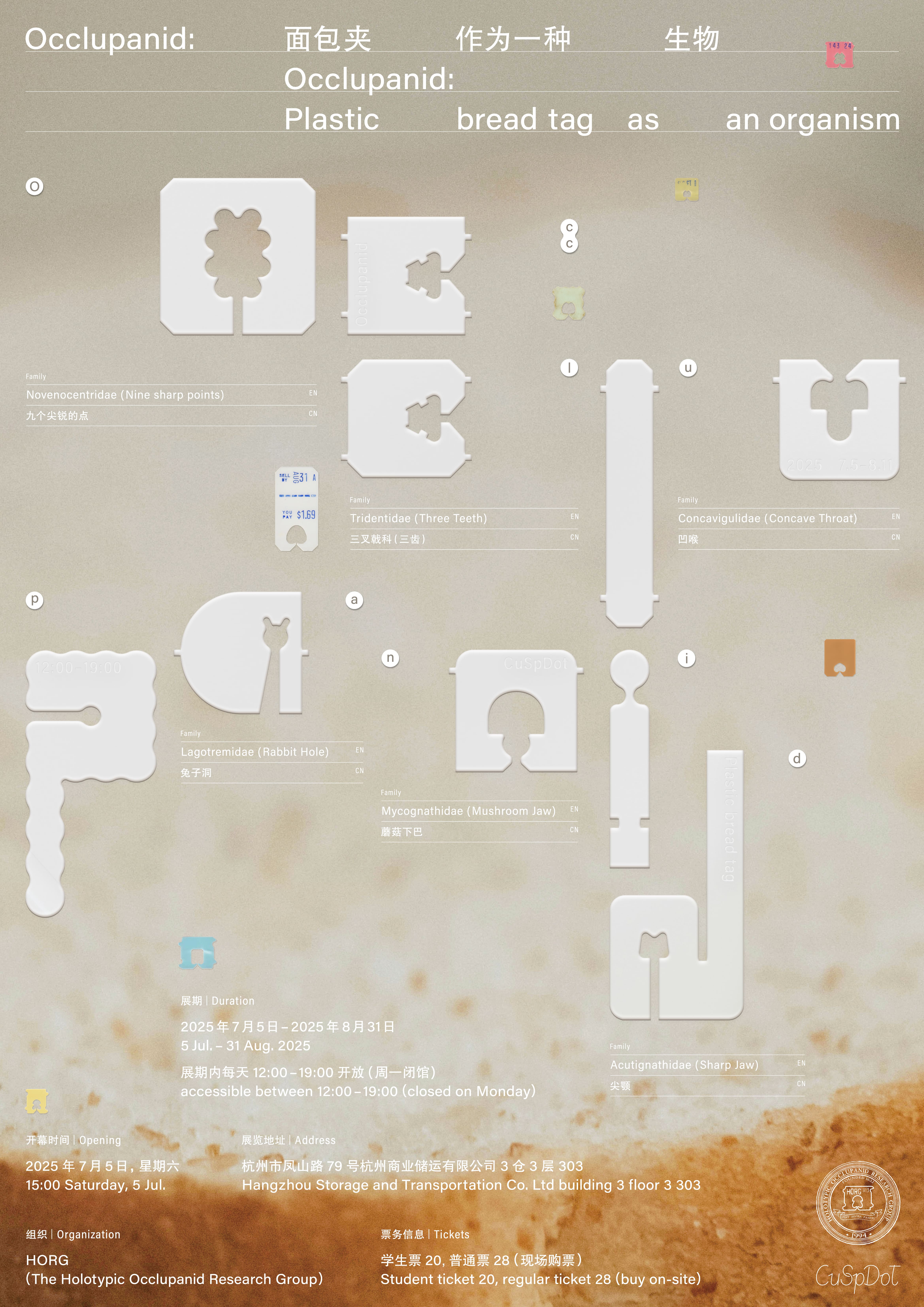
Occlupanid: Plastic bread tag as an organism
Duration:
5 Jul.– 31 Aug. 2025
accessible between 12:00 - 19:00 (closed on Monday)
Organization:
HORG
(The Holotypic Occlupanid Research Group)
Address:
Hangzhou Storage and Transportation Co. ltd building 3 floor 3 303
Duration:
5 Jul.– 31 Aug. 2025
accessible between 12:00 - 19:00 (closed on Monday)
Organization:
HORG
(The Holotypic Occlupanid Research Group)
Address:
Hangzhou Storage and Transportation Co. ltd building 3 floor 3 303

The exhibition ‘Occlupanid: Plastic bread tag as an organism’ presents the work of Holotypic Occlupanid Research Group (HORG), which since 1994 has been promoting the classification of a new species - called Occlupanid - and meticulously documenting and categorising bread tags from around the world through the lens of biology. The exhibition runs from 5 July to 31 August 2025.
The term Occlupanid comes from the Latin verb Occludere, meaning to close, and Pan or Panis, the Latin root of bread. The exhibition attempts to emphasise how an everyday object - The Plastic bread tag - acquires the status of a ‘species’ through a long process of collection, observation, and mimetic narratives. In HORG’s practice of pseudo-natural history, bread tags are systematically re-defined as ‘species’, using morphological traits and ecological behaviors drawn from biological taxonomy. This strategy reveals how such objects carry the residual logic of civilisation’s systems of distribution and attempts to establish a new narrative system for materiality. Through this ironic approach, the politics of classification are humorously subverted, navigating the space between seriousness and satire, and reflecting the mechanisms of object recoding in modern consumer society. In the eighteenth-century system of taxonomy, Carl Linnaeus established a rational model of order for the world through visual comparisons of morphology forms. In contrast, HORG’s classification deliberately highlights a ‘hypothetical natural history’, with taxonomic standards based on the arrangement of teeth in the occlusal groove, mimicking the nomenclature of insect wing veins. This strategy functions both as a humorous deconstruction of the authority of traditional scientific classification and as an artistic intellectual intervention, revealing the social consensus mechanisms hidden behind scientific images through the practice of absurd formalism. In this process, the bread tag is no longer a marginal waste attached to the neck of a plastic bag, but becomes a metaphorical node of the civilised order: How does it enter the system? How does it acquire meaning? And at what point is it swiftly forgotten? As a ghost species in the culture of objects, the Occlupanid reminds us—through its near-absurd existence—that naming is never merely descriptive, but a way of reconstructing the world amid apparent meaninglessness.
Through its overall curatorial approach, the exhibition also seeks to guide the audience to observe and record different Occlupanids from a biological perspective: scientific methods can be used to depict a leaf or a bird, but why can't they be used to trace the evolution of a plastic closure? Similarly, the exhibition seeks to reconstruct the viewer's way of observing nature, both living and non-living, through the lens of an everyday object: the bread tag. From the material to the pictorial, from the supermarket to the archive, from humour to the everyday - this is a practical process of how things grow, how they are seen, and ultimately, how they are learned.
On the other hand, bread tags (Occlupanids) are born from the act of sealing. The act of sealing has never been absent in the development of human civilisation. Whether it is the binding of grain or the art of knotting a rope to bring fruit into a pouch, the sealer has always been at the hidden node of material traffic, order establishment and categorical governance. In this context, the osten-sible meaninglessness of Occlupanids, as small industrial artefacts of modern consumer society, conceals a deep cultural logic.
As revealed by the Holotypic Occlupanid Research Group (HORG), these tiny plastic objects are involved not only in packaging processes, but also in the social compartmentalisation of the ‘visible’ and the ‘invisible’. Unconsciously manipulated and discarded in the aisles of supermarkets, they act as ‘miniature ghosts’, carrying the hidden structures of contemporary material culture. Further-more, from the perspective of material culture studies, the ‘sealing technology’ embodied by the bread tags should not only be regarded as a low-tech residue, but also as a key interface object in the highly institutionalised logistics system. It connects the contents with the outside world, the manual with the mechanical, the temporary freezing of time with the flow path of goods. In a sense, the sealer itself is a microcosmic expression of ‘civilisation’: the containers in which humans put and seal their substances are the basic means of maintaining social order, systems of trust, and rhythms of exchange. As HORG ironically points out in its research archive, ‘where you find the occlupanid, you find civilisation’, a statement that is not only a humorous biomimetic observation, but also a grim look at ‘how things make order’ in consumer society. Within the context of the philosophy of technology, this artistic practice that mimics the methods of scientific inquiry—constitutes a unique form of ‘epistemological theatre’: it not only demonstrates how knowledge is constructed and visualised, but also reveals the persistent blurring of boundaries between science and imagination, rigour and absurdity. As Bruno Latour once proposed, science is not the pursuit of truth, but a practice of ‘world-making’. In the world of HORG, this idea is pushed to an ironic extreme: a meaningless plastic object, once subjected to a ‘scientific’ ritual of classification, produces a biogeographical narrative more orderly—and more absurdly coherent—than that of any real insect.
As a form of exhibition situated somewhere between museum and absurdist theatre, this project not only challenges the viewer’s fundamental assumptions about ‘what constitutes nature’ and ‘what defines a species’, but also reactivates reflection on ‘how the micro shapes the macro’—how small things generate large systems. Through the figure of the bread tag, HORG constructs a cultural ecosystem tinted with the colours of ‘satirical natural history’: a formally complete yet hypothetical knowledge system that distorts through simulation, and through distortion, reflects the epistemic apparatus of the real world. In this sense, this is not merely an exhibition about bread tags (Occlupanids), but a broader reflection on the act of sealing, the civilisational history of objects, and the very forms through which knowledge is produced.
“Occlupanid:面包夹作为一种生物”展览呈现 Holotypic Occlupanid Research Group(HORG)从 1994 年开始对于面包夹进行新的物种提倡 —— 称之为:Occlupanid,以及以生物学的方式进行仔细记录和分类世界各地面包夹们的全部内容,展期从2025年7月5日至8月31日。
Occlupanid 这个词来源于拉丁语动词Occludere,意思是关闭,以及Pan或Panis,这是面包的拉丁语词根。展览尝试强调日常物件——面包夹——如何通过长期的收集、观察与拟叙事而获得“物种”的地位。在HORG的拟自然史实践中,面包夹被系统性地重构为“物种”,以生物分类法中的形态特征与生态习性加以再定义,这一方式揭示出物品如何承载文明分配逻辑的残余形态,也试图建立一种新的物性叙事系统。这种戏谑的方式嘲讽分类政治,在幽默与严肃之间游走,折射出现代消费社会中物的再编码机制。在18世纪的分类学体系中,卡尔·林奈通过视觉上的形态比较,为世界建立起一个理性的秩序模型。然而HORG的分类则刻意凸显一种“假设性的自然史”——其分类标准基于Occlusal Groove(口腔沟)的牙齿排列方式,模拟昆虫翅脉的命名方法。这种策略既是对传统科学分类权威的幽默解构,也是一种艺术性的知识干预,通过荒诞的形式主义实践揭示出科学图像背后隐藏的社会共识机制。在这一过程中,面包夹不再是附着于塑料袋口的边角废料,而成为文明秩序的隐喻节点:它如何进入系统?如何承载意义?又何时被迅速遗忘?Occlupanid作为物文化中的幽灵物种,以近乎荒谬的方式提醒我们:物的命名从来不仅关乎描述,也关乎我们如何在看似无意义中重建世界
展览也试图通过整体策展带领观众以生物学的方式去观察记录不同的Occlupanid:科学的手段可以用于描绘一片树叶、一种鸟类,为何不能用于追踪一个塑料封口件的演化轨迹?同样展览也想要通过观察面包夹这一日常物件而反向重新构建起观众对于自然,生物,非生物等一切内容的观察方式。从物质到图像,从超市到档案,从幽默到日常——这是一种关于物如何生长、如何被观看,最终如何被学习的实践过程。
另一方面,面包夹(Occlupanid)也是从封口这一行为而诞生。在人类文明的发展过程中,封口行为从未缺席。无论是捆扎粮食的束缚物,还是将果实收入袋囊的结绳技艺,封口器始终处于物质交通、秩序建立和分类治理的隐秘节点。在这一语境下,面包夹(Occlupanid)作为现代消费社会中的工业小件,其表面上的无意义恰恰掩盖了一种深层的文化逻辑。正如 Holotypic Occlupanid Research Group(HORG)所揭示的,这些微小塑料物不仅参与了包装流程,也参与了对“可见与不可见”的社会区隔。它们在超市走道中被无意识地操控与遗弃,宛如“微型幽灵”,携带着当代物质文化的隐藏结构。进一步地,若以物文化研究的视角观察,面包夹所代表的“封口技术”不应仅被视作低技术残余,而应被视为高度制度化的物流环节中关键的界面物(Interface Object)。它连接着内容物与外部世界、手工与机器、时间的暂时冻结与商品的流通路径。从某种意义上讲,封口器本身就是对“文明”的缩影表达:人类将物质装入容器并加以封闭,是维持社会秩序、信任系统和交换节奏的基本手段。正如HORG在其研究档案中讽刺地指出的,“你在哪里发现咬合体,你就在哪里发现文明”,这一说法不仅是幽默的拟生物观察,更是对消费社会中“物如何制造秩序”的冷峻观察。在技术哲学的语境中,这种模拟科学研究方法的艺术实践构成了一种独特的“知识剧场”(Epistemological Theatre):它不仅展示了知识如何被建构、被可视化,也揭示出科学与想象、严谨与荒谬之间始终存在的边界模糊。布鲁诺· 拉图尔(Bruno Latour)曾提出,科学并非发现真理的路径,而是一种“缔结现实”的实践;在HORG的世界里,这一点被反讽地推进到极致:一个无意义的塑料物件,经过“科学”的分类仪式之后,其生物地理学的叙述比起真实昆虫更具秩序,也更具荒诞的逻辑自洽性。
作为一种介于博物馆与荒诞剧之间的展览形式,本次项目不仅挑战了观众对“什么是自然、什么是物种”的基本判断,也重新激活了我们对“微物如何制造宏观秩序”的思考。HORG通过面包夹构建了一种深具“讽刺博物学”色彩的文化生态系统:一个基于假想却形式完备的知识体系,它在模拟中失真,在失真中映照出真实世界的认知装置。由此而言,这也并非完全关于面包夹的展览,而是一次对封口行为、物的文明史以及知识生产形式本身的反思。

Exhibition Map :
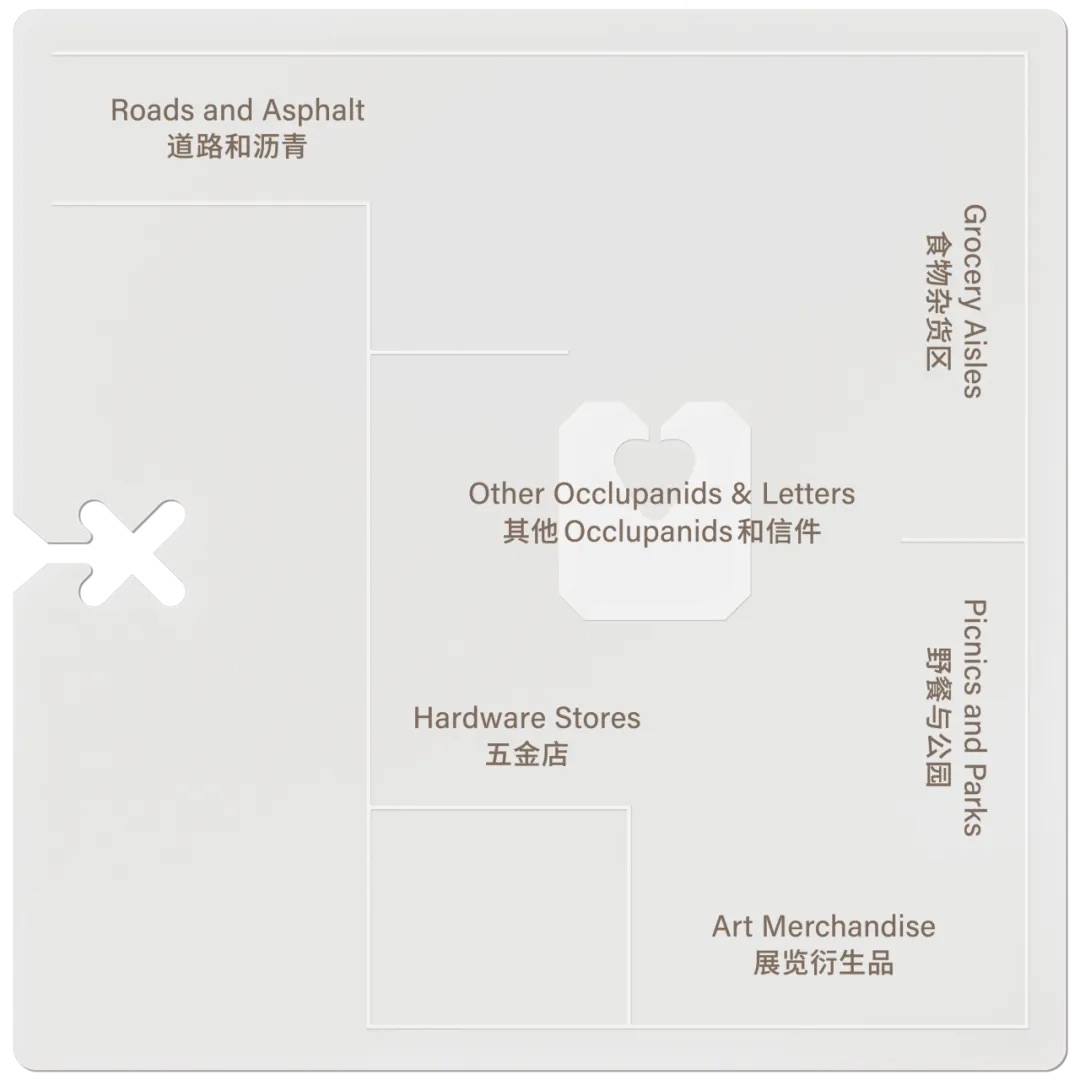
What is Occlupanid?
Occlupanids are generally found as parasitoids on bagged pastries in supermarkets, hardware stores, and other large commercial establishments. Their fascinating and complex life cycle is unfortunately severely under-researched. What is known is that they take nourishment from the plastic sacs that surround the bagged product, not the product itself, as was previously thought. Notable exceptions to this habit are those living off rubber bands and on analog watch hands.In most species, they often situate themselves toward the center of the plastic bag, holding in the contents. This leads to speculation that the relationship may be more symbiotic than purely parasitic.
Their stunning diversity and mysterious habits have entranced many a respectable scientist into studying, collecting, and cataloging specimens late into the night.HORG contains several years of research in the classification of occlupanids. For those of you who do not consume sliced bread, occlupanids do not form an important part of your life. For the rest of the world, These small objects are everywhere, dotting supermarket aisles and sidewalks with an impressive array of form and color.The Holotypic Occlupanid Research Group has taken on the mantle of classifying this most common, yet most puzzling, member of phylum Plasticae.
什么是Occlupanid?
Occlupanid 通常被发现寄生在超市、五金店以及其他大型商业场所的包装糕点上。它们那令人着迷又复杂的生命周期至今仍严重缺乏研究。目前已知的是,它们并不是像之前所认为的那样从食物本身摄取营养,而是从包裹食物的塑料袋中获取养分。值得注意的例外包括那些以橡皮筋为生或寄居在模拟指针手表上的种类。在大多数物种中,它们通常会安置在塑料袋中央,用来封住袋口。这引发了一个猜想——它们与人类的关系可能不只是寄生,更是一种共生关系。
它们令人惊叹的多样性与神秘的行为,吸引了许多正经的科学家深夜研究、采集与分类标本。HORG 汇集了多年关于Occlupanid 分类的研究。对那些从不吃切片面包的人来说,Occlupanid 也许无足轻重;但对世界上其他人来说,这些小物体无处不在,点缀在超市走道和人行道上,展现出令人印象深刻的形态与色彩。Holotypic Occlupanid Research Group已经承担起了为这一塑料门中最常见却最令人困惑的成员进行分类的重任。


A small portion of Occlupanids from HORG
来自HORG的小部分Occlupanids
如何观察一个Occlupanid How to Observe a Occlupanid:
Firstly we can follow the taxonomy and observe the broad category to which this Occlupanid you are viewing belongs - that is, the family it belongs to, and different families will have different forms of Occlupanid. Then we can determine the ecological classification in which it will appear based on the guide icon, e.g.: grocery section, hardware shop, road.... (There are some Occlupanids that appear in more than one ecology, and there are some occlupanid that appear in places that are not clear.) You can find these two pieces of information in the top right corner of each Occlupanid's guide card, and then you can read about its background information, as well as reacquaint yourself with its humorous aliases by its physical shape. Next you can try to collect the stamps or look closely at them with a magnifying glass, or try to find the differences between two different breadcrumbs, and of course you can use the colours or geographic location to find clues to your observation of the Occlupanids.
首先我们可以按照分类学的方式,观察你正在观看的这个面包夹所属的大类——也就是它属于的科,不同科的面包夹会有不同的形态。然后我们可以根据导视图标确定它会出现的生态分类,比如:食品杂货区,五金店,道路…。(有一些面包夹会出现在多个生态里,有一些面包夹出现的地方并不清楚。)你可以在每一个面包夹的导视卡片的右上角找到这两个信息,然后可以阅读它的背景信息,也可以通过它的体态形状重新去理解它幽默的别名。接下来可以尝试盖章收集或者是用放大镜仔细去观察他们,也可以尝试寻找两个不同面包夹之间的差异,当然你可以用颜色或者地理位置找到你观察面包夹的线索。

Different families of Occlupanid
Occlupanid的不同科

Occlupanid的结构
Collection: Collect Occlupanid figures of various morphologies from the gallery;
Observation: Observe the mouth-hook structure, number of teeth, symmetry, and distribution of fissures in Occlupanids;
Measuring: Measure the dimensions of different Occlupanid;
Imagine & Envisioning: Imagine more possibilities for the Occlupanids; After reading the background information of various Occlupanids, envision/imagine the hidden stories behind the scenarios in which they appear;
Classification and Nomenclature: Classify the Occlupanids into families and genera based on the characteristics you have observed, and assign Latin or pseudo-Latin names;
Recording: Draw morphological diagrams in the research manual with notes on possible ecological functions and behavioural hypotheses.
采集:在展厅内收集不同形态的Occlupanid图形;
观察:观察Occlupanid的口钩结构、牙齿数目、对称性与裂隙分布等等;
测量:查看不同的Occlupanid的尺寸;
想象和设想:想象面包夹形态更多的可能性;阅读不同的Occlupanid的背景资料以后设想他们出现的场景背后的故事;
分类与命名:依据你所观察的特征,划分科属,并使用拉丁文或拟拉丁命名;
记录:在研究手册中绘制形态图,附注可能的生态功能与行为猜测。
部分面包夹们 Some of the Occlupanids:

这一罕见而独特的Occlupanid至今仍是个谜。其锋利的锯齿状口腔沟与明显的猫头鹰形态特征显然是了抓住某种强大的东西,但研究人员却无法解释这究竟是什么。在已采集的少量标本中,无一是在原生栖息地发现的。期待未来能揭开关于它的更多信息。

An occlupanid out of time. Occlupanids of family Acutignathidae are exceedingly rare in grocery biomes, as many have been thought to be extinct in the wild. For a brief moment in 2023, Occlupanologist Kurisu (FORC) observed this ‘non-living fossil’ parasitizing bags of Shahrazad Lebanese Bread in Sydney, Australia.
However, in the span of a few days, all sightings of E. sarpolatus had disappeared altogether, and all such host breads were now parasitized by Palpatophora utiliformis. Even more curious, the integument of many such recently-collected specimens appear to show signs of deep aging. Had they been dormant all this time like a frozen mastodon, only to reawaken ages later in a changed world that had no place for them? Their tragic mystery is compounded by their small lateral palps- each collected specimen has at least one or more palp missing or trimmed.
一只超越时空的Occlupanid。Acutignathidae科的Occlupanid在杂货生态系统中极为稀有,因为许多被认为在野外已经灭绝。在2023年的短暂时刻,Occlupanid研究员Kurisu(FORC)在澳大利亚悉尼观察到这种“非生物化石”寄生在Shahrazad黎巴嫩面包袋上。
然而,在短短几天的时间里,所有对E. sarpolatus的目击完全消失了,而所有这些宿主面包现在都被Palpatophora utiliformis寄生了。更令人好奇的是,许多最近收集到的标本的外皮似乎显示出深度衰老的迹象。它们是否像一只冰冻的猛犸象一样一直处于休眠状态,直到在一个已经发生变化、没有它们位置的世界中重新苏醒?它们悲剧性的谜团被它们的小侧触须的状态加剧——每个收集到的标本至少有一只或更多触须缺失或被修剪。

Shokupan is the Japanese name for sandwich bread. Nearly two decades after the first and only Shokupanus specimen was brought to the attention of HORG, no less than three Angulognathids were discovered by occlupanologist T. Pepperella, who found them during an occlupanological survey in Akita, Japan, along with several other occlupanids endemic the region. The specimens of S. pepperellae were found on bags of Japanese pastries, much like their conspecific. Its rectangular oral groove is 2mm deeper than that of S. mihashii.
Shokupan是日语中对三明治面包的称呼。距第一只、也是唯一一只Shokupanus标本被HORG注意到,已将近二十年。如今,Occlupanid研究员T. Pepperella在日本秋田进行一次Occlupanid调查时,竟发现了不少于三种Angulognathid,同时还记录了几种该地区特有的Occlupanid。S. pepperellae的标本是在日式点心的包装袋上发现的,这与其同种的亲缘物种相似。该种的矩形口腔沟比S. mihashii的要深2毫米。

A delightful oddity of tiny proportions. Adoralepus kadyae was discovered during an excavation of a discontinued Calico Critters toy set. Searching deep underneath layers of miniature plastic canned goods, miniature bananas and miniature boxes of corn flakes, occlupanologist C. Ayers (FORC) unearthed a small but sturdy 9mm square occlupanid firmly attached to a minute bag filled with rabbit-themed plastic bread products. A. kadyae possesses softly rounded edges, and a unique interior morphology; it has a small rounded oral groove with slight angles (bringing to mind the endolateral dential processes of the Toxodentidae), with the anterior oral groove reduced to two small furrows. There is also a possibility that we are looking at a new species of Concavigulidae, or perhaps a close relative. Species discovered and described by C. Ayers.
一件令人喜爱的微型奇物。Adoralepus kadyae是在挖掘一套已停产的森贝儿家族(Calico Critters)玩具时发现的。Occlupanid研究员C. Ayers(隶属 FORC)在一层层微型塑料罐头、微型香蕉和迷你玉米片盒的下面,挖掘出一个虽小却坚固的咬口夹——边长仅9毫米,稳稳地附着在一个装有“兔子主题塑料面包制品”的微型袋子上。 A. kadyae拥有柔和圆润的边缘,以及独特的内部结构:它的口腔沟为小巧的圆形,略带几何角度(令人联想到Toxodentidae的内侧突触结构);其前部口腔沟则缩减为两条细小的纵沟。研究者推测,这可能是Concavigulidae的新物种,或是其近缘类群。该物种由C. Ayers发现并命名。

Two distinct color morphs of this large and unique Archignathid were discovered by field researcher L. Vaid in an industrial laboratory in Lake County, Illinois. Both were found unattached to any host entity, but the close proximity of both specimens to large bags of polypropylene reaction vessels has led to the prevailing hypothesis that this was their primary host. The large scar-like disks on each color morph of A. thermastris has even led to speculations that these might have aided the occlupanid in locomotion like vestigial feet, allowing them to wander short distances when unobserved. But the discovery of such a distinctive occlupanid in a new biome is tempered by this observation from Vaid; recent shipments of plastic bottles have arrived, closed not with occlupanids, but with beaded zip-ties. The specimens now held in the HORG archives may well be those of an endangered species.
Despite this dour prospect, there is still reason for hope. Occlupanologists are now finding specimens in a wealth of new biomes. The recognition of “Laboratories and Industrial Settings” by the Council on Abiotic Distribution has not only opened an exciting new venue of exploration and research, it has also allowed the HORG graphics department to realize a long-sought goal: A legitimate excuse to create a tiny Erlenmeyer flask icon for our public database.
这种体型较大且独特的Archignathid Occlupanid物种A. thermastris,有两个明显不同的色型,于伊利诺伊州莱克县一家工业实验室内被野外研究员L. Vaid发现。两个个体均未附着于任何宿主实体,但因其出现场所临近大量聚丙烯反应容器包装袋,因此目前主流假说认为这些反应容器可能是其主要宿主。在A. thermastris的两个色型中均可观察到显著的疤痕状圆盘,这也引发了一种猜测:或许这些结构曾在运动中起到辅助作用,类似退化的足部,使其能在无人察觉时进行短距离移动。不过,在这一新生态域中发现如此独特的Occlupanid令人振奋的同时,也被Vaid的后续观察所泼了一盆冷水:近期运抵的塑料瓶已不再以Occlupanid封口,而是使用了珠链式扎带。现藏于HORG档案馆的这两个标本,或许正是一个濒危物种的最后残迹。
尽管这一前景略显灰暗,但仍有希望的理由。Occlupanid学家们如今正陆续在众多新生态域中发现标本。“非生物体分布委员会” (Council on Abiotic Distribution) 对“实验室与工业环境”的正式承认,为研究与探索开启了令人振奋的新舞台。也使得 HORG图像部门得以实现他们长久以来的梦想:终于有了一个合法理由,在我们公开数据库中加入一个微型锥形瓶图标。

This arresting and unique Archignathan was discovered in great quantities by occlupanologist T. Brys during the Texas State Fair, the majority of them collected on the ground near the Texas Star Ferris Wheel. A subsequent expedition discovered their host organism- plastic bags filled with cotton candy. It appears that D. texastertrochus uses its secondary vesicle to hang securely from metal pegs. Every occlupanid collected sports the same deep red hue. The striking secondary vesicle and life habits have pushed occlupanologists to move this Cyrtotergum ally into its own genus, along with D. trexlerii.
这只引人注目且独特的Archignathan由Occlupanid学家T. Brys在得克萨斯州博览会期间大量发现,绝大多数标本采集自得克萨斯星形摩天轮附近的地面。随后的一次考察确认了它们的寄主——装有棉花糖的塑料袋。D. texastertrochus似乎利用其次级囊泡牢牢挂附于金属钉上。所有采集到的个体均呈现深红色。其醒目的次级囊泡结构及生活习性促使Occlupanid研究员将其与D. trexlerii一同,从 Cyrtotergum亲缘群中独立,划分为独立属。

Though placed in genus Diplacofelis, scholars have wondered whether this occlupanid species, were it to be folded bilaterally, would indeed resemble that of a cat, or some other animal entirely. Since HORG only has a single holotype of this specimen, all such multiplanar musings must remain theoretical. No host data known at present. Discovered and described by C. Huning (DWORC).
尽管被归入属Diplacofelis,学者们仍然怀疑若将该Occlupanid物种进行双侧折叠,是否真会像猫,或是完全像另一种动物。由于 HORG目前仅保存有唯一标本,所有此类多维度的推测仍只能停留在理论阶段。当前无已知宿主数据。该物种由C. Huning(DWORC)发现并描述。

This incredibly rectangular archignathid was discovered by occlupanologist A. Leu on a bag of bandage padding in a Tennessee veterinary clinic. Of particular note is the primitive raptorial stricture; a simple asymmetric division between oral grooves, as opposed to a more developed set of oral hooks. This curious morphology evokes images of the “Hypothetical Ancestral Occlupanid” debated by scholars since the dawn of occlupanology. Could this recent species have a connection to the rise of orthogonodectids? Or are we witnessing a fusing of oral grooves, as some have theorized regarding the Fusoridae? Its oral groove and integument also sheds more light on another tantalizing mystery- that of Cryptocolax lilidonum, which shares similar characteristics.
这只极具矩形特征的Archignathid由Occlupanid研究员A. Leu在田纳西州一家兽医诊所的绷带填充袋上发现。特别值得注意的是其原始的捕食性结构——口腔沟之间的简单非对称分隔,而非更为发达的口钩。这一奇特的形态让人联想到自Occlupanology诞生以来学者们争论的“假想祖先Occlupanid”。这新近发现的物种是否与Orthogonodectids的兴起有关?或者,我们是否正目睹口腔沟的融合过程,正如有人对Fusoridae所提出的理论?其口腔沟和表皮结构也为另一迷团提供了线索——Cryptocolax lilidonum,其特征相似。

This archignathid, with its cardiorid oral groove, was found in a chocolate shop in Meridian, Idaho. Specimen collected on a bag of confections, with long white amicula attached. Despite its unique circumstance and diligent accession data, Glycodontis charma managed to evade detection in the HORG offices for many months, but was eventually rediscovered. The HORG Board of Taxonomy maintains that it must have been seeking out palatable sweets, which the staff break room notably lacks. Field researchers are therefore advised to bring a watchful eye (as well as a bag of decent candy) when attempting to collect this occlupanid. Discovered and described by occlupanologist M. Stay.
这只具有心形口腔沟的Archignathid,最初在爱达荷州梅里迪恩的一家巧克力店中被发现。标本采集自糖果包装袋,附着有白色Amicula。尽管其采集背景独特且资料详实,Glycodontis charma仍在HORG办公室"潜伏"多月,最终才被重新发现。HORG分类委员会坚持认为,它一定是在寻找美味的甜食,而这正是工作人员休息室显著缺乏的。鉴于此,野外研究人员在采集该Occlupanid时被建议带上警惕的眼睛和一袋好糖果。该物种由Occlupanid研究员M. Stay发现并描述。
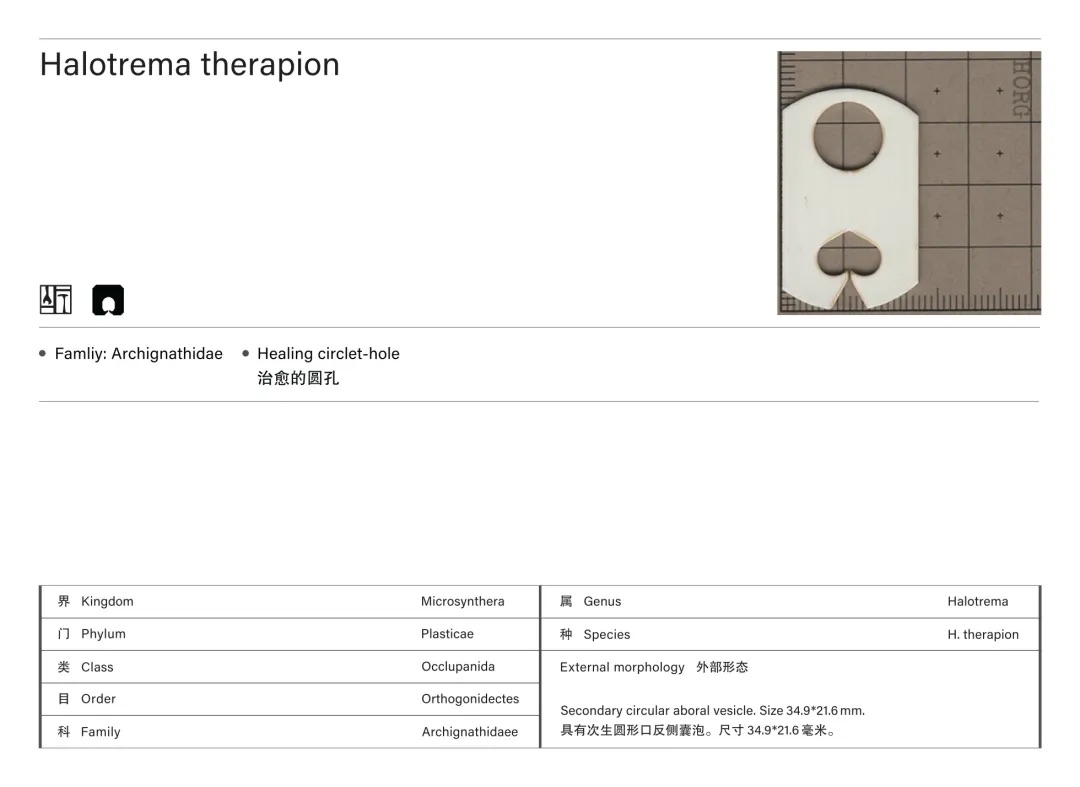
Discovered by field collectors F. van den Berg and T. Meijering, in the town of ‘s-Graveland in the Netherlands. Bearing a secondary aboral vesicle much like that of genus Deuterofenestrum, Halotrema therapion is distinguished by its larger vesicle and its cardiorid oral groove, with its angled center. This rare occlupanid was found in a rather rarified environment: inside a cotton box of a first aid kit. It is unknown if H. therapion was attached to cotton bandages themselves, or to a larger plastic containing bag. More samples and observations are clearly needed.
由野外采集者F. van den Berg与T. Meijering于荷兰的Graveland镇发现。Halotrema therapion拥有类似Deuterofenestrum属的腹侧辅助囊泡,但其囊泡更大,且具有中心呈一定角度的Cardiorid的口腔沟,因此得以辨识。该稀有Occlupanid出现在一个颇为特殊的环境中:一套急救包的棉布盒内。目前尚不清楚H. therapion是附着于棉质绷带本身,还是附着于更大的塑料外袋上。显然,需要更多的样本与观察来进一步研究。

This incredibly specialized Archignathid possesses an oral groove like no other; One oral hook is thick and stunted, while the one opposite is caved in sharply upward. Meanwhile, its oral groove is shrunken and curled to one side. According to its discoverer S. Nottingham, these occlupanids are only found attached to rubber bands of produce, not baked goods. No other location data present, presumed to be found in the New South Wales region of Australia. The lack of any dential processes places it firmly under the Archignathidae, but it is possibly a Family unique to itself. It is hoped more species (and specimens) can be made available to scientific analysis.
这是一种高度特化的Archignathid,其口腔沟结构与众不同:一侧的口钩粗短钝化,而相对的一侧则向上剧烈凹陷。同时,口腔沟整体缩小并偏向一侧弯曲。据发现者S. Nottingham观察,这类Occlupanid仅附着于蔬果类橡皮筋上,而非烘焙食品包装。目前无其他产地数据,推测分布于澳大利亚新南威尔士地区。由于缺乏任何齿突结构,其被明确归入Archignathidae,但也有可能构成一个独立的科系。希望未来能有更多物种与标本可供科学分析研究。
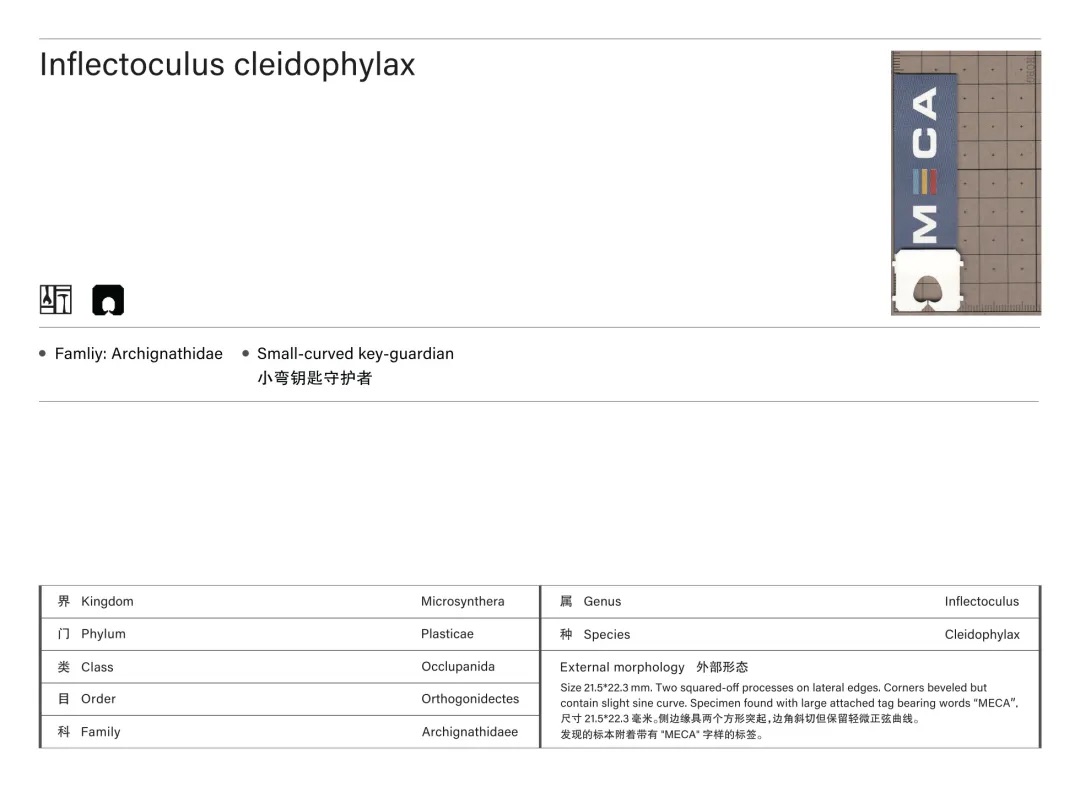
Discovered by R. Schneider in a car repair shop in Norway. It had a firm grip on a set of automobile keys. The attachment to a metallic instead of plastic host is a significant find that may link it to some of the minute archignathans found on watch dials.
该物种由R. Schneider在挪威一家汽车维修店中发现。当时它正紧紧夹住一串汽车钥匙。与金属物体 (而非塑料包装) 之间的附着关系,是一个重要的发现,可能将它与某些曾在手表表盘上发现的微型Archignathan联系起来。

During a survey of the Yau Ma Tei Fruit Market in Hong Kong in pursuit of Kurisuphenax edentulus, occlupanologist Kurisu discovered a second species, with angled distal coxae. No amicula present. It otherwise shares many of the same features as K. edentulus; rounded oral hooks with almost no inward curve, a textured and flexible integument, and is ever-so-slightly closer a mimic of Infirmamaxilla kurisu, the eponymous archignathan first discovered attached to large wrapping-paper around grapes in this very same locale. Does K. secondus benefit from being a closer mimic to I. kurisu? The mendacious qualities of this occlupanid genus must be taken into account when collecting in the field; K. secondus are known to persuade their human hosts to prevaricate on the purchase price. Exercise caution!
在香港油麻地果栏进行对Kurisuphenax edentulus的调查时,Occlupanid研究者Kurisu发现了第二个物种,其远端突节呈角状。未观察到饰带。除此之外,该物种与K. edentulus在诸多特征上高度相似:口腔沟圆润,几乎没有内弯;表皮具纹理且具有柔性;并且作为对 Infirmamaxilla kurisu的拟态体,稍微更加相似——Infirmamaxilla kurisu是在同一地点、缠绕葡萄的礼品纸上首次发现的同名Archignathan。K. secondus是否因更接近I. kurisu的拟态而获得优势?在野外采集中,必须对该属的欺骗特性保持警惕:据知K. secondus会诱使人类宿主在议价时说谎。请务必小心!

While many occlupanids can be imaginatively said to have personality, none rival the haunting visage of Latericavus pareidolia, submitted by an enigmatic explorer from Tucson known as C. Whatever. The unique invaginations in L. pareidolia’s lateral edge are arresting enough in their own right, but when combined with the heart-shaped oral groove it generates an unmistakable and unnerving humanoid expression that haunts the dreams of our restless researchers. While more level-headed scientists are keenly interested in the discovery of a new anatomical feature, many of our scholars are disturbed by its anthropomorphized morphometrics, perceiving a face locked in stress and fear, wide-eyed and howling into the void.
尽管许多Occlupanid都被富有想象力地赋予了某种“个性”,但没有哪个能比得上Latericavus pareidolia那令人不安的“面孔”。这一标本由一位来自图森、化名为C. Whatever的神秘探索者提交。L. pareidolia侧缘上独特的内陷结构本已引人注目,而当它们与中心心形口腔沟相结合时,更形成了一种无法忽视、令人毛骨悚然的人形表情,令本机构众多研究员夜不能寐。尽管头脑冷静的科学家们对这种新解剖特征的发现充满兴趣,但不少学者却被其“拟人化”的形态深深扰动,仿佛看见一张陷入惊恐与痛苦的面孔,睁大双眼,在虚空中无声呼号。
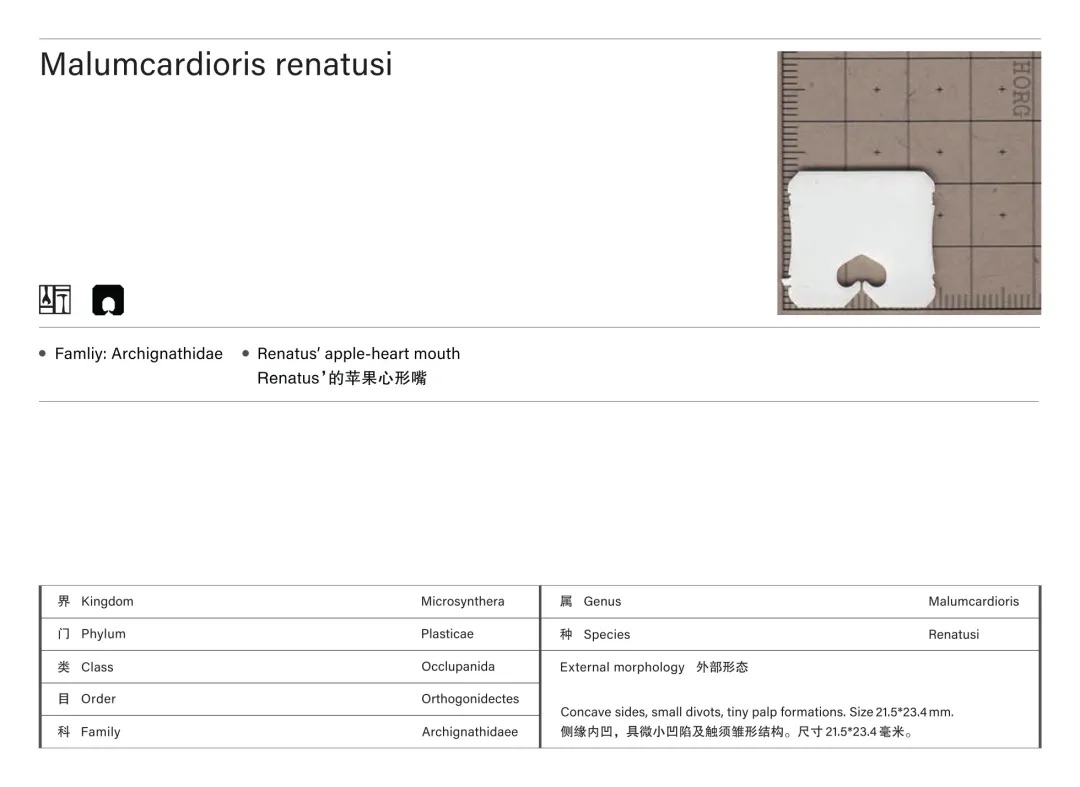
Laterally concave sides distinguish this charming cardiorid species, with only the merest hint of palp formation. It was found in a crisper drawer by occlupanologist A René, attached to a bag of apples. The intrepid researcher noted the occlupanid’s “adaptation to extreme cold, and ability to gain nutrients from a host that doesn’t contain grain products.”
侧凹的体侧是这只迷人的心形科物种的显著特征,触须形成仅有极其微弱的迹象。该物种由Occlupanid研究员A René在蔬果保鲜抽屉中发现,附着于一袋苹果上。这位无畏的研究者指出,该面包夹“适应了极端寒冷环境,且能从不含谷物成分的寄主中获取养分。”。
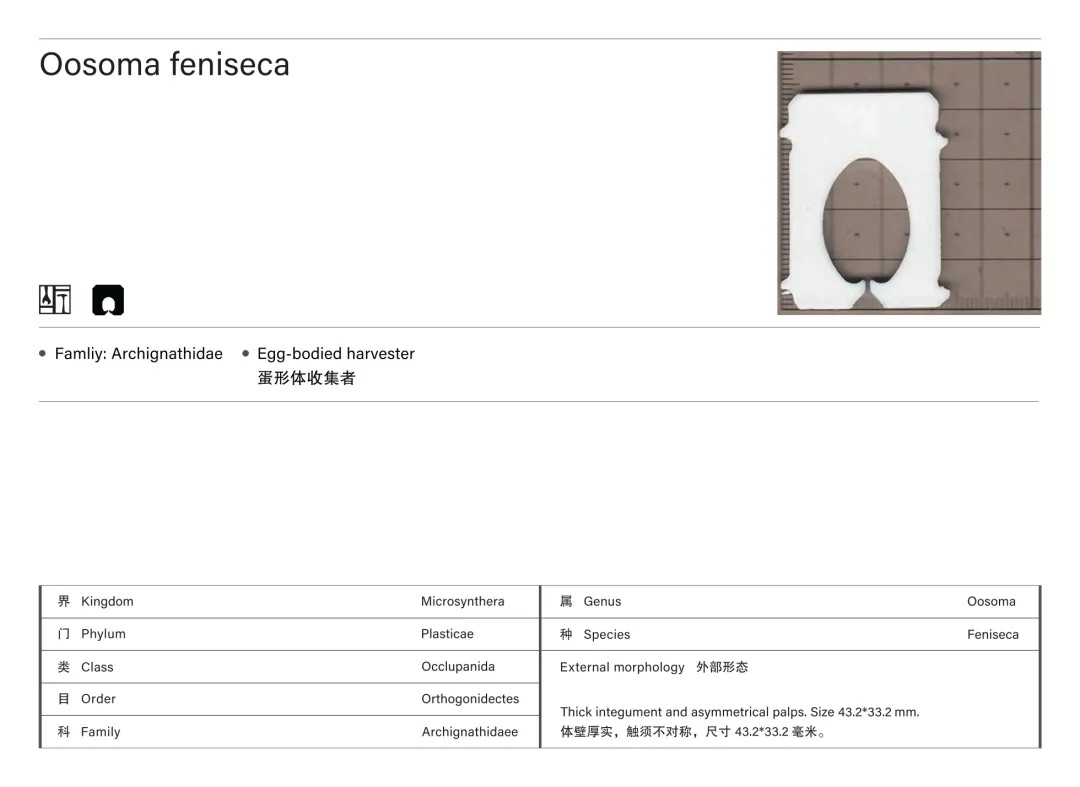
Discovered in Florida by occlupanologist M. Radzilowski. All specimens were observed parasitising a bag of Kaytee brand timothy hay.
本种由咬合学家M. Radzilowski在佛罗里达州发现,所有标本均寄生于Kaytee品牌提摩西干草包装袋上。
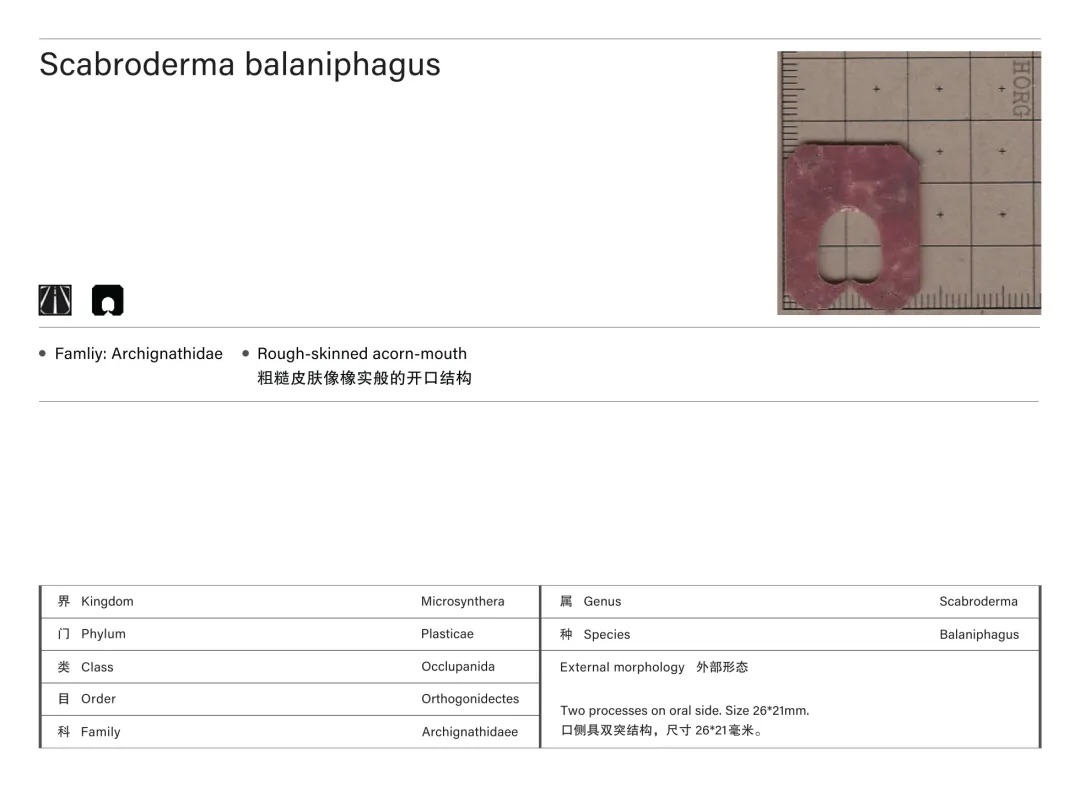
Little is known about this occlupanid, except that it’s in terrible shape.
关于这只Occlupanid,目前仅知其保存状况极为糟糕。
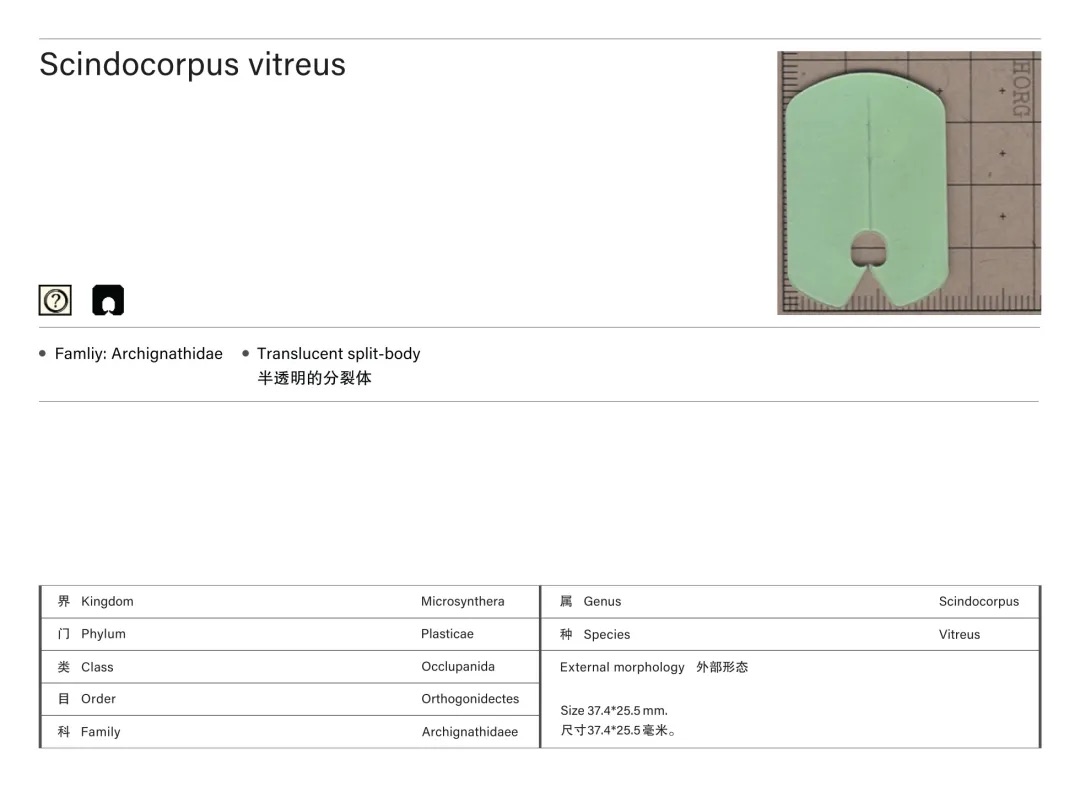
In addition to the unique bilateral fissure that runs along the length of its integument, Scindocorpus vitreus is also remarkable for its translucent glass-green appearance, and the unprecedented presence of a thin film of paper that entirely coats its (presumably) ventral side. Its oral groove is slightly smaller than that of S. bivultus. Thought to be endemic to Australia. Species submitted and described by C. Huning (DWORC). Its host entity and other habits are unknown at present.
除了其体表贯穿全长的独特双侧裂缝外,Scindocorpus vitreus还因其半透明的玻璃绿色外观而令人瞩目,并首次观察到其(推测为)腹侧完全覆盖着一层薄纸膜。其口沟略小于S. bivultus。据信为澳大利亚特有种。由C. Huning(DWORC)提交并描述。目前尚不清楚其宿主实体和其他习性。

Named after its resemblance to a Japanese Torii gate. Discovered by occlupanologist M. Cech on an analog wrist watch, nestled securely between case and crown. Cech observed that the watch remained inoperable until the occlupanid was removed. It is therefore possible that T. torii produces targeted inhibitors that can stop time. Handle with caution.
因其外形与日本的鸟居神社门相似而命名。由Occlupanid研究员M. Cech在一只机械腕表上发现,安全地嵌入表壳与表冠之间。Cech观察到,直到该Occlupanid被移除之前,腕表一直无法运作。因此,有可能T. torii产生了某种特定的抑制物质,能够停止时间。请小心处理。
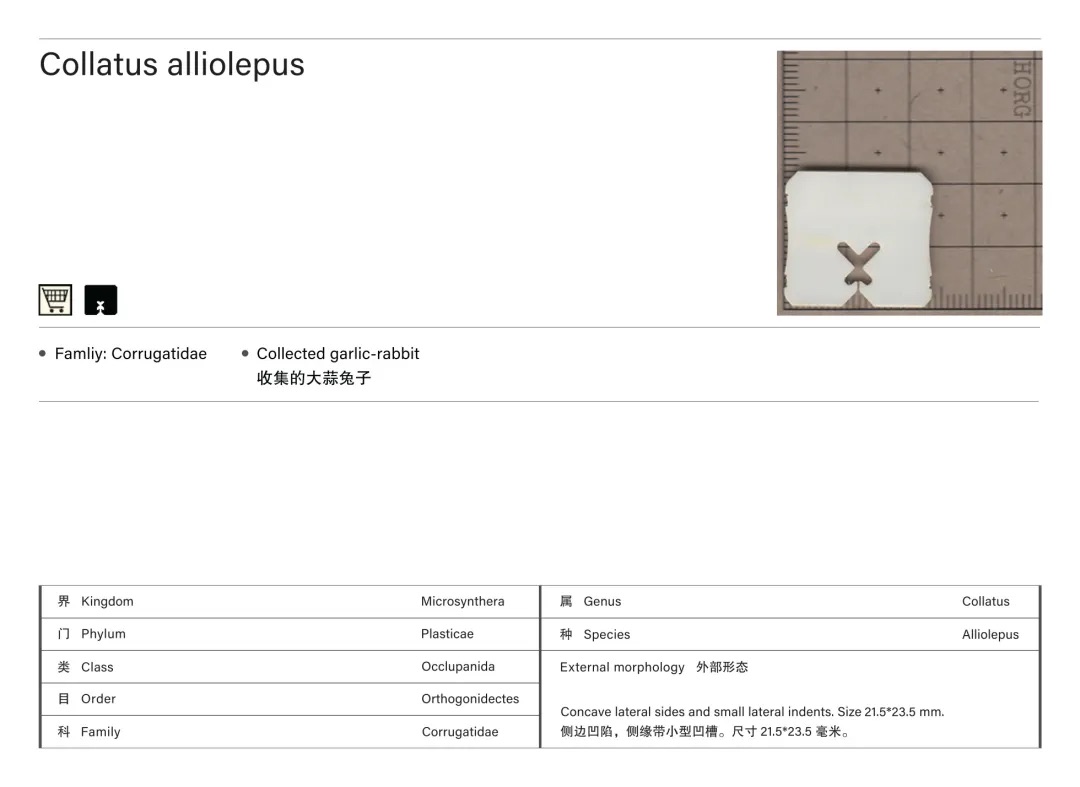
First collected in Colorado in 2017 by scholar L. Greeen. This specimen remained a quiescent enigma until 2021, when occlupanologist D. Estabrook (FORC) deduced that this might be a member of the furtive genus Collatus. Improbably, no sooner was this sample sent to HORG than identical specimens were discovered in California, attached to mesh bags of garlic. This occlupanid clearly shares some of the same near-preternatural prestidigitative traits as C. mysteriosa, managing to confound collectors while hiding in plain sight. Species named for its resemblance to a rabbit’s nose.
首次由学者 L. Greeen于 2017 年在科罗拉多州收集到。这个标本一直是一个沉寂的谜团,直到2021年,Occlupanid研究员D. Estabrook(FORC)推测这可能是隐秘的Collatus属的一员。令人难以置信的是,这个样本送到HORG后,不久就在加利福尼亚被发现,附着在装有蒜头的网袋上。这个Occlupanid显然具备与C. mysteriosa相似的几种近乎超自然的魔术般特性,能够在明目张胆的情况下困扰收集者,巧妙地隐藏自己。物种的命名灵感来自它与兔子鼻子的相似形状。
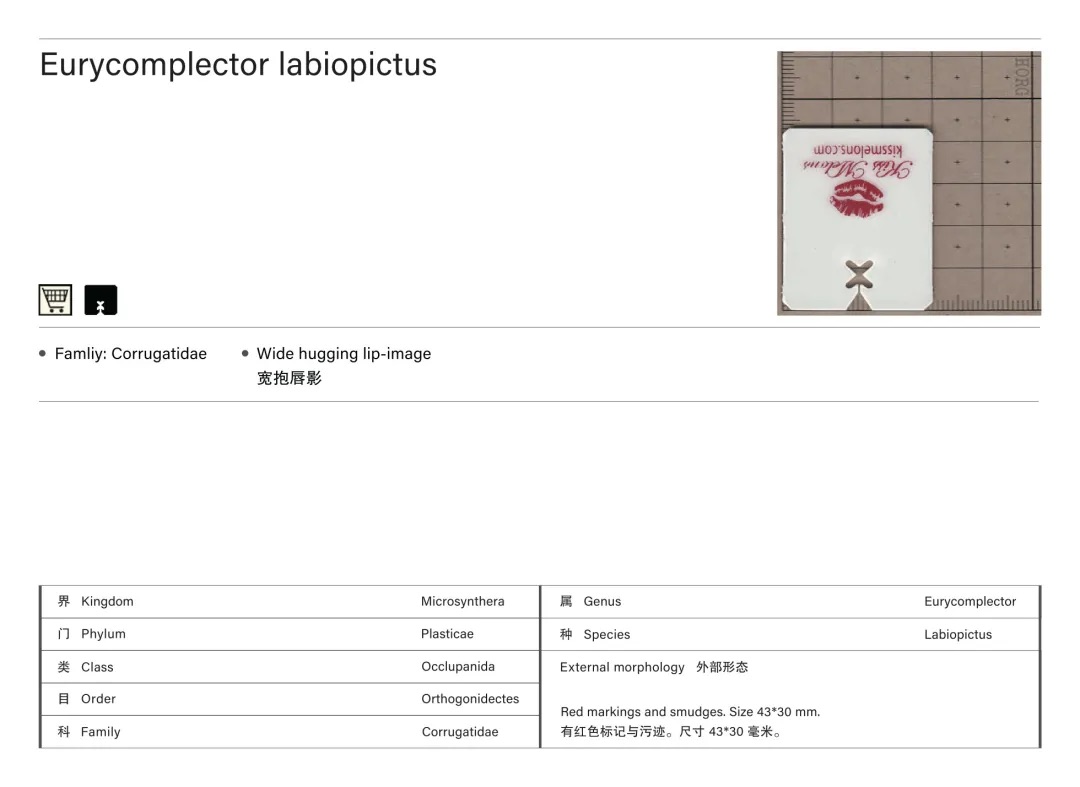
Simultaneously discovered by S. Kinsey (in a Korean market) and T. Brys (at a Walmart), in each case attached to a large bag of domestic melons. The splotch-like markings are of especial curiosity, so far unique to our records. It may indeed be some form of camouflage, akin to the spots on a leopard. Since leopards have on average 800 to 1200 spots per organism, perhaps these Occlupanids are more effectively camouflaged in groups.
由S. Kinsey (在一家韩国超市) 与 T. Brys (在沃尔玛) 几乎同时发现,两者皆附着在一大袋本地蜜瓜上。其斑块状的花纹格外引人注目,目前在我们的档案中尚属首次记录。这种花纹或许确实是一种伪装机制,类似豹类身上的斑点。考虑到每只豹平均拥有800至1200个斑点,也许这些Occlupanid在成群出现时,伪装效果更为显著。
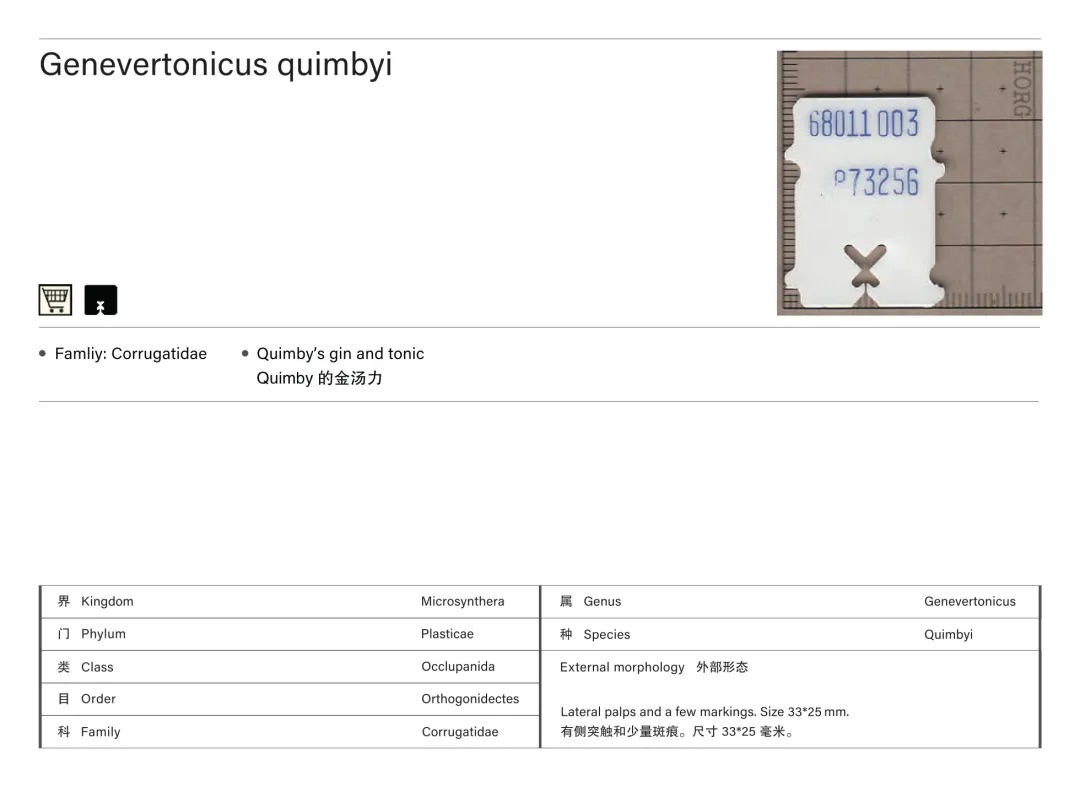
Inadvertently discovered by a dirigible airship captain on a voyage to collect ingredients for gin and tonics. G. quimbyi was found tightly attached to a plastic mesh bag of limes.
该标本由一位飞艇船长在采集金汤力鸡尾酒原料的航行中意外发现。G. quimbyi当时正紧密附着于一个装青柠的塑料网袋上。

After co-authoring a paper with Dr. Bruce Ragsdale, the resulting worldwide attention of the Holotypic Occlupanid Research Group prompted many HORG researchers to finally deal with the huge backlog of undescribed and unattended specimens in the archives, and to redesign the obsolete website for use by the public at large. During this overhaul, four single specimens of an entirely unknown taxon were discovered in a small unlabeled cardboard box. These four are to date the only examples of the recently-named family Concavigulidae. It is hoped more information of its life and habits will come to light, but for now it remains a pleasing mystery, named in honor of two eminent proponents of occlupanology.
在与Bruce Ragsdale博士共同撰写论文后,Holotypic Occlupanid Research Group(HORG)引起的全球关注促使许多HORG研究人员终于开始处理档案中大量未描述和未处理的标本,并重新设计了过时的网站,以供大众使用。在这一更新过程中,四个单独的未知物种标本在一个没有标签的小纸箱中被发现。这四个标本迄今为止是最近命名的Concavigulidae科的唯一例子。希望更多关于其生命和习性的资料能浮出水面,但目前它仍然是一个令人愉快的谜团,以表彰两位杰出的Occlupanology提倡者而命名。
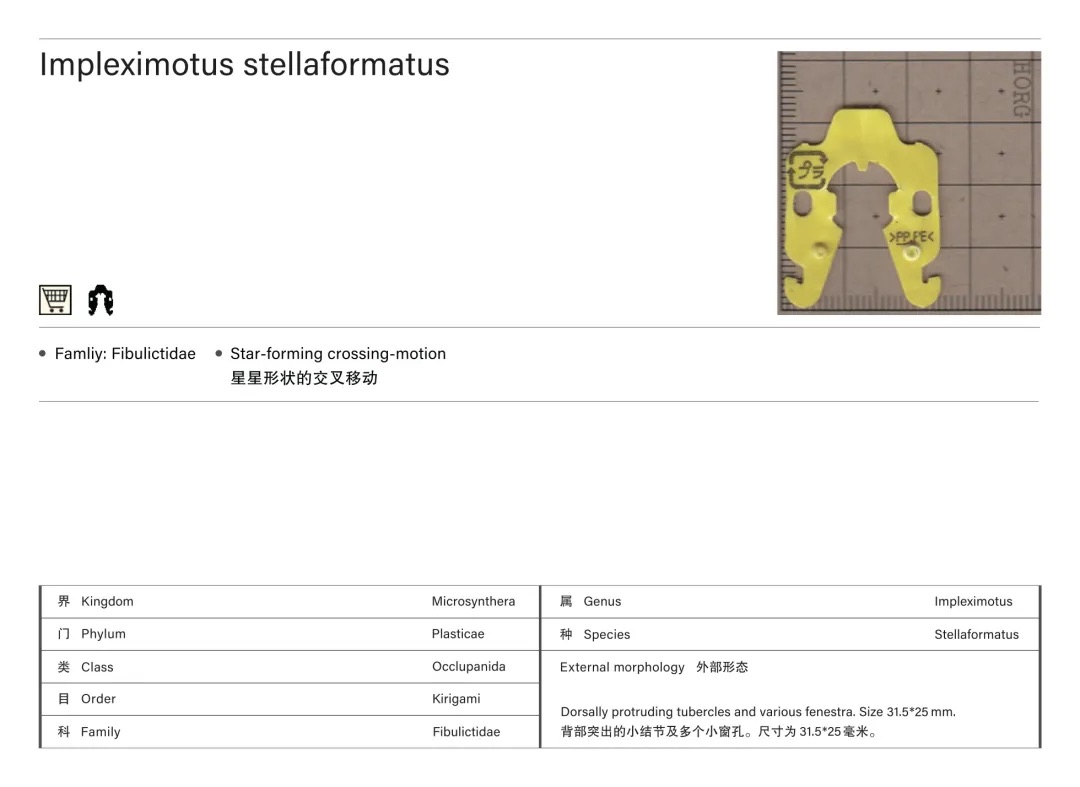
Discovered in Hong Kong by occlupanologist Kurisu (FORC), Impleximotus stellaformatus has been observed preying on bags containing a variety of produce, including sweet potatoes, onions, chestnuts, and oranges. Its large oral groove containing three dential processes distinguishes it from its fellow Kirigamid occlupanids. Field observations of I. stellaformatus have reported a unique and disturbing aspect of its parasitism, one that suggests this occlupanid is affecting not only the plastic bag it is attached to, but altering the internal structure of the bag’s contents. Further research could shed light on a potentially complex host-parasite relationship.
由Occlupanid研究员 Kurisu (FORC)在香港发现,Impleximotus stellaformatus被观察到寄生于多种农产品包装袋上,包括红薯、洋葱、栗子和橘子等。其具有包含三根齿状突的大型口沟,是区别于其他同属Kirigamid occlupanids的重要特征。对I. stellaformatus的田野观察报告中,还描述了其寄生行为中独特且令人不安的一面:这种Occlupanid不仅影响附着的塑料袋本身,还可能在一定程度上改变袋内物品的内部结构。进一步的研究有可能揭示一种潜在的复杂宿主—寄生体关系。
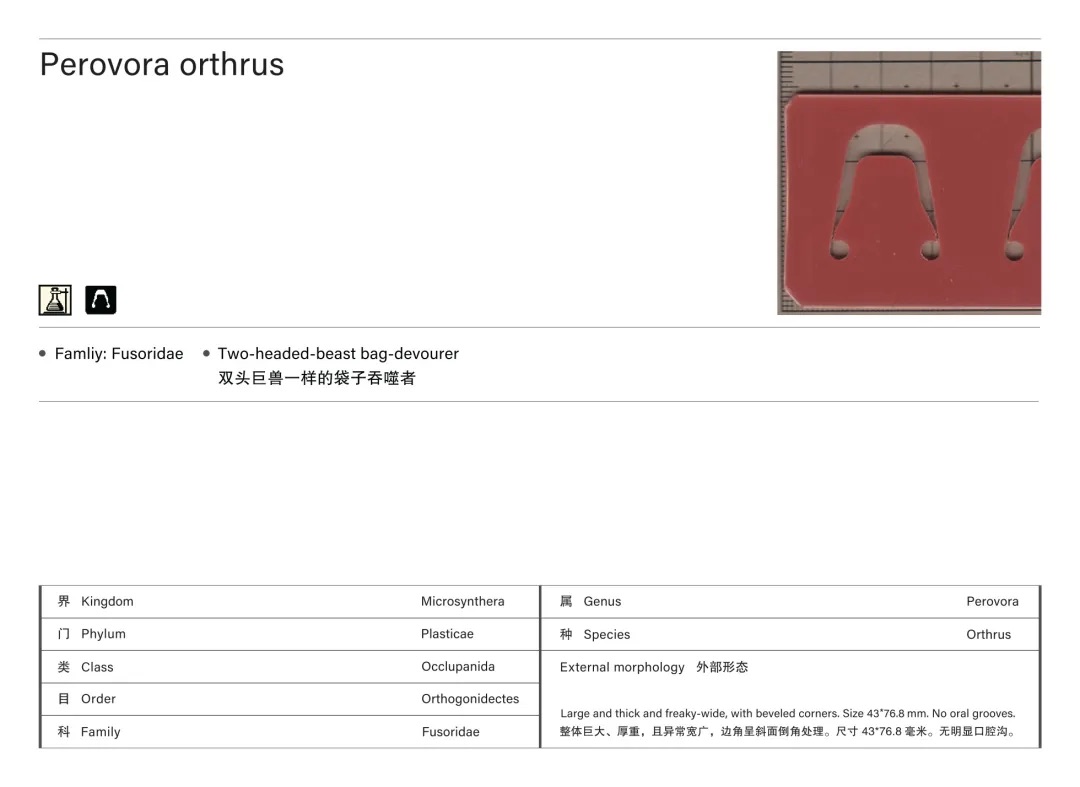
Discovered in an industrial warehouse in Yakima, WA by occlupanologist D. Estabrook (FORC). A bizarre duopareidolian enigma that has caused nights of restless agitation in some of our most sensitive systematists, already at their wits end from studying the unusual morphology of the newly uncovered Fusoridae. While many occlupanids are thought to possibly reproduce by budding laterally, Perovora orthrus is solidly conjoined, a fusion of fused plastic. The twinning of this entity is thought to be an adaptation as an obligate parasite of large previously-opened bags of chips. Host data remain elusive, as none of the precious few Fusorids D. Estabrook was able to collect were found attached to any host. Indeed, it is unknown if these newly discovered giants are relics of a bygone era, colossal monsters from the dawn of the Synthetic Age.
由Occlupanid研究员D. Estabrook(FORC)在美国华盛顿州亚基马市的一座工业仓库中发现。这是一种奇异的Duopareidolian(双重拟像)谜团,曾让研究新发现Fusoridae物种、已然身心俱疲的系统分类学家们在夜晚辗转反侧。虽然许多Occlupanids被推测可能通过侧芽繁殖,但Perovora orthrus 的形态是彻底融合的,呈现出一块融合塑料体的连体结构。这种“双生现象”被认为是其作为大型、已开封薯片袋专性寄生者的一种适应性进化结果。关于其宿主的确切数据仍然缺乏,因为D. Estabrook能够收集到的极少数Fusorids标本中,没有一例是在附着于宿主时被捕获的。事实上,尚不清楚这些新发现的巨型咬缝类是否是某个逝去时代的遗迹——或许是Synthetic Age初期诞生的庞大怪物。
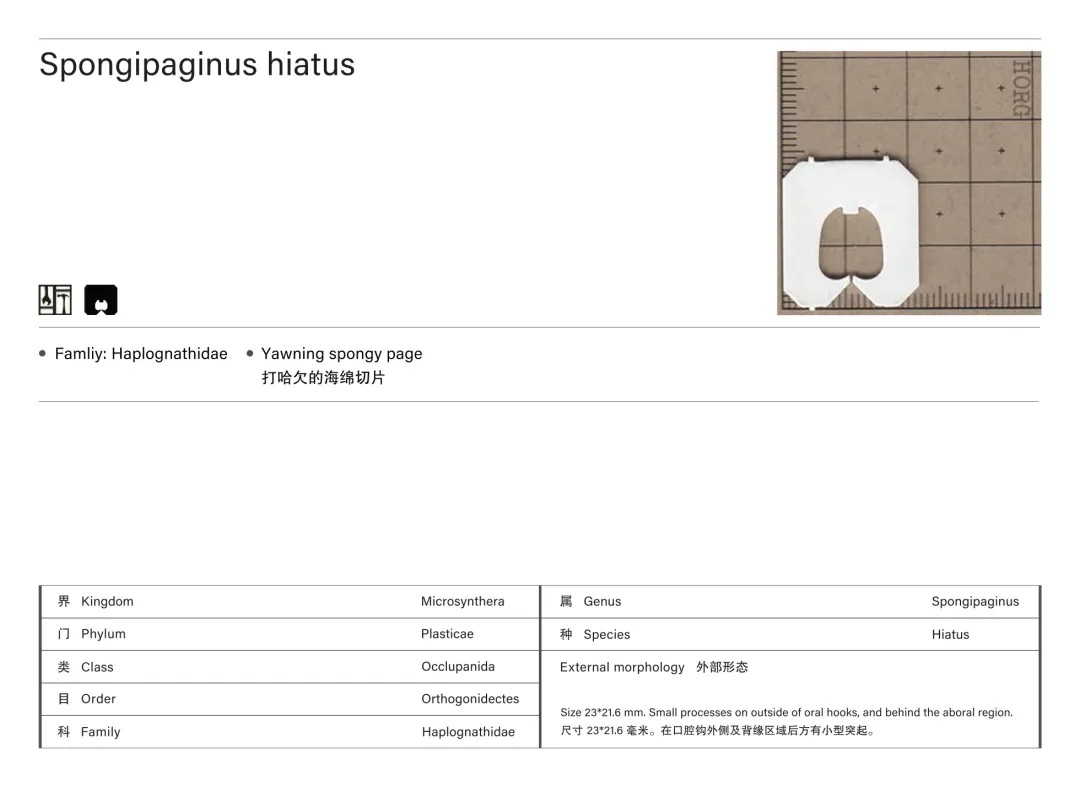
Specimen found attached to roll of project foam sheets. Discovered in Osawatomie Kansas in 2019 by amateur occlupanologist T. Friend. Large flexible arms around a large oral groove distinguish this thin yet sturdy occlupanid. S. hiatus has also been observed in other unique host entities such as quilt batting.
标本附着于一卷泡沫垫片材料上,于2019年由业余Occlupanid学家T. Friend在堪萨斯州奥萨瓦托米市采集到。这种薄却坚韧的Occlupanid以其围绕大型口腔沟的宽大柔韧触腕为显著特征。此外,S. hiatus也曾在其他特殊宿主实体上被观察到,如被子棉絮。
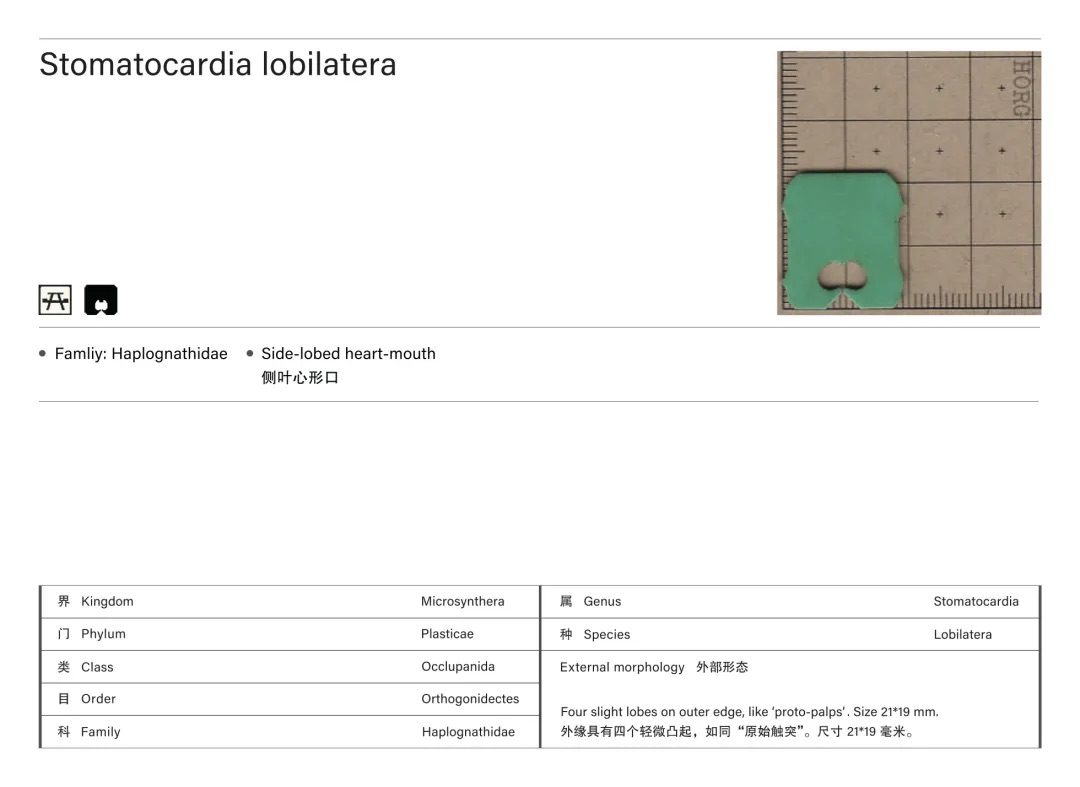
To quote occlupanologist EF Lipton, “An odd little duck.”
就像Occlupanid研究员EF Lipton所形容的那样:“一只奇怪的小鸭子。”
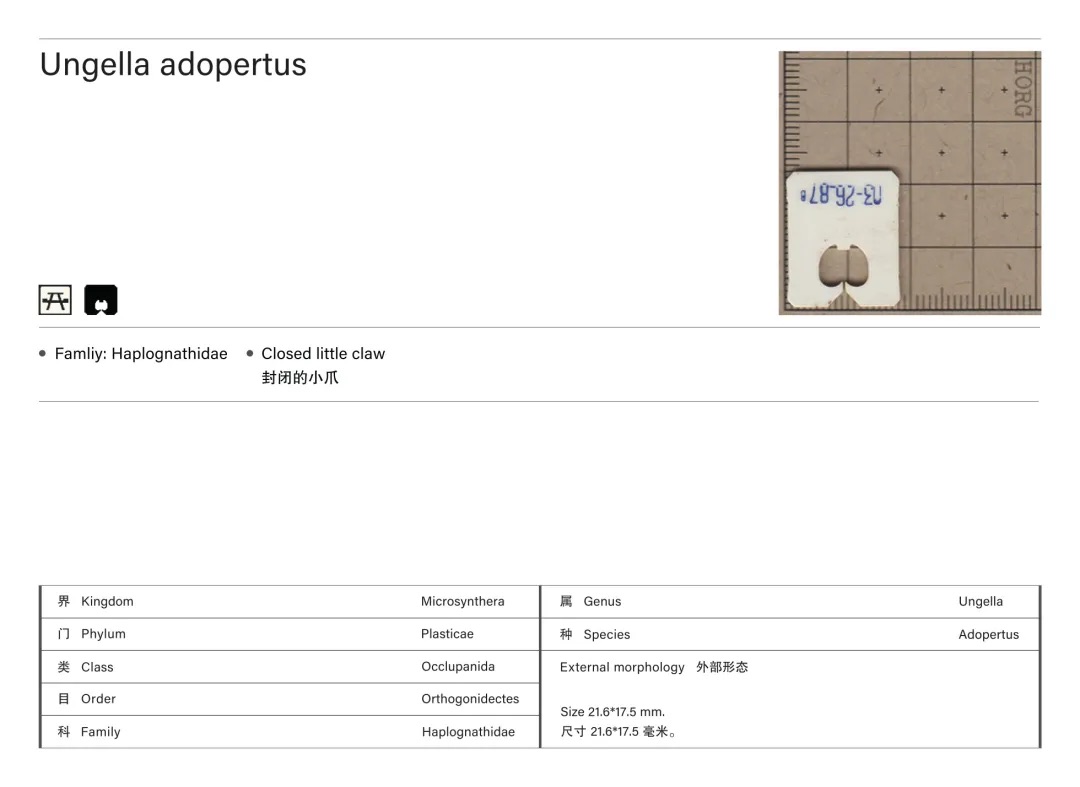
Collection information of this specimen is unknown, but U adopertus was recently sighted in picnic ground in Melbourne, Australia. Unusually for an occlupanid, the markings, “03_26_87” on this specimen seem to indicate the date of March 26, 1987, which according to our records would have been a Thursday. What this particular Thursday meant to the occlupanid is a mystery, but if these markings are accurate it could make it one of the oldest confirmed occlupanids in our archives. Submitted and described by occlupanologist C. Huning. (DWORC).
该标本的采集信息不详,但U. adopertus最近曾在澳大利亚墨尔本的野餐区被目击发现。与大多数的Occlupanid不同,U. adopertus 标本上印有“03_26_87”的字样,似乎指向1987年3月26日这一日期——据现有记录,那天是星期四。至于这一特定的星期四对这种Occlupanid意味着什么仍是个谜题。如果这一日期标记属实,它可能是目前档案中确认的最古老的Occlupanid标本之一。物种由Occlupanid研究员C. Huning(DWORC)提交并描述。
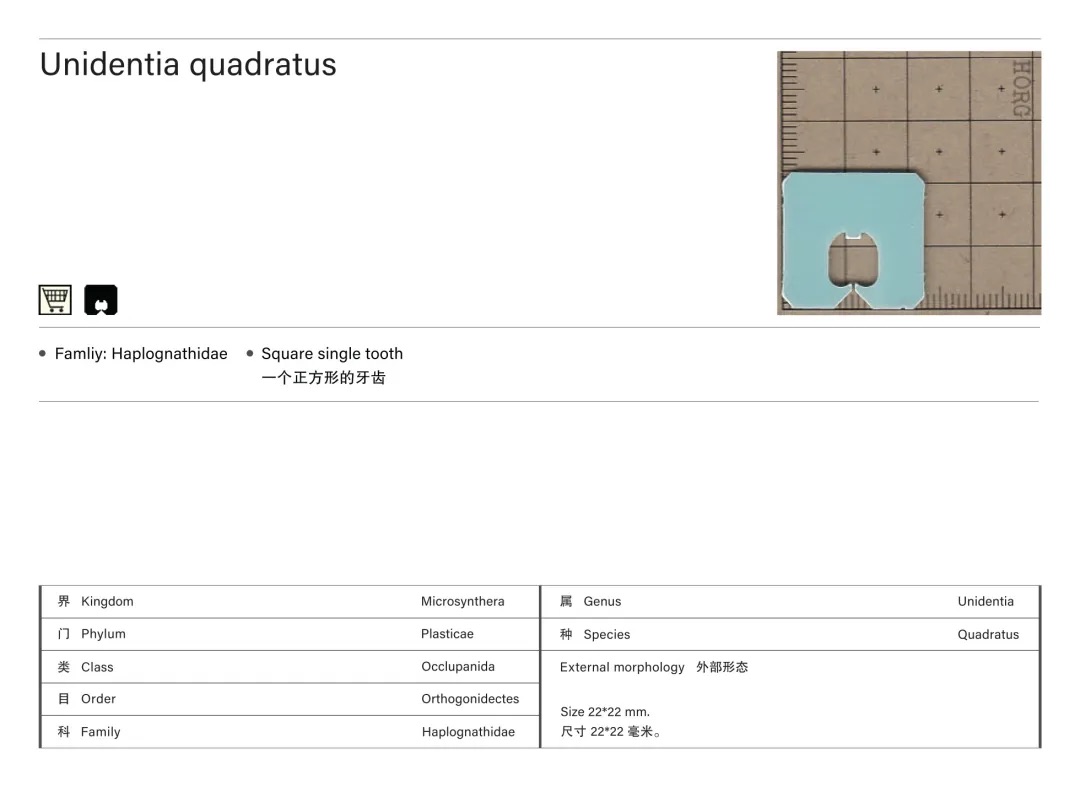
The most basal of haplognathids. Found in supermarkets across the Nearctic region. As regular as it gets. Dependable.You can set a watch to that square, telling you what.
这是Haplognathids中最原始的成员之一。广泛分布于近新北界 (Nearctic) 各地超市,它规律得几乎无可挑剔——可靠、稳定,堪称典范。你甚至可以用它那方方正正的形状来校准时间。
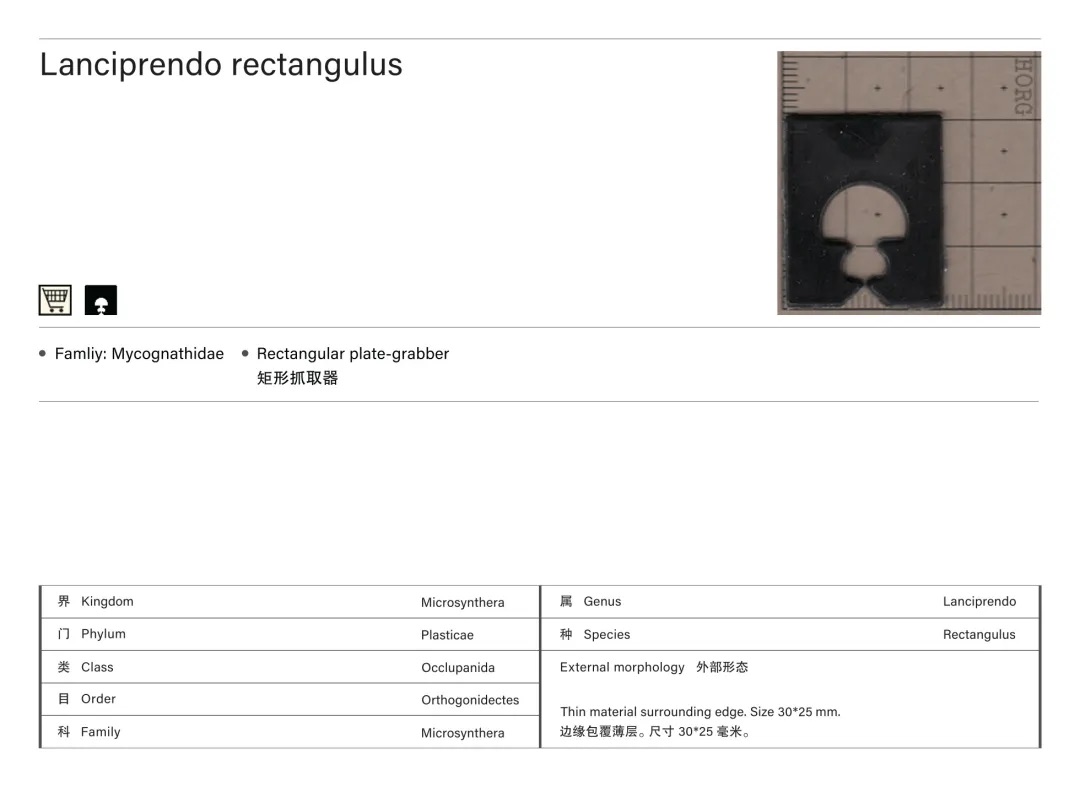
DWORC acquired this rather unusual specimen of occlupanid in an SF bay area Smart and Final. It was found clinging to a bag of paper plates and bowls. The unique mushroom-shaped oral groove and thickly flanged integument has led to a proposal for L. rectangulus to be placed within its own taxonomic family, the Mycognathidae.
DWORC于旧金山湾区地区的一家Smart and Final(仓储式食品和供应商连锁店)获取到这只不寻常的Occlupanid标本,其附着于纸质餐具套装的包装袋表面。基于独特的伞菌状口沟结构及显著增厚的的表皮结构,研究组提议将L. Rectangulus归入单独的分类学科——Mycognathidae科。
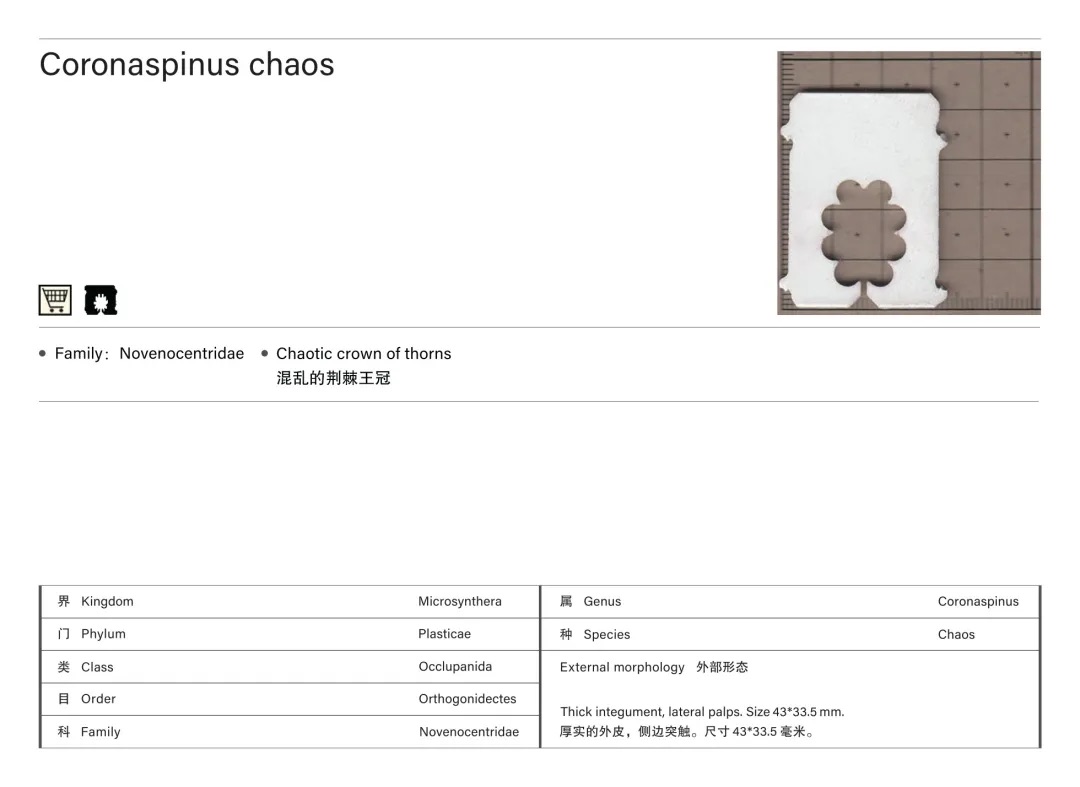
In the frenetic days just before the shelter-in-place orders of 2020, panicked shoppers swarmed into grocery stores before they and other businesses shut down to slow the spread of COVID-19. In between all the jostling shopping carts piled high with baking good and toilet paper, occlupanologists L. Swehla and C. Ebert noticed this huge occlupanid lurking suspiciously on the floor of a Berkeley produce market. Hypnotized by their find, they brought it to HORG. Whatever hapless host organism that was held in its unrelenting oral groove is, at the moment, unknown.
2020年居家隔离令颁布前夕,为遏制COVID-19传播而即将关闭的零售场所内,涌入大批恐慌的购物者。在伯克利农产品市场堆满烘焙原料与卫生纸的购物车之间,Occlupanid研究员L. Swehla与C. Ebert发现了一个潜伏在地面的巨型Occlupanid个体。该发现令两位学者为之着迷,他们将其移送至HORG,目前尚未确定被其口腔沟捕获的原宿主为何物。

Specimen discovered in a drawer by B. Miller-Jacobson of Rochester. It was theorized to have been originally attached to bags of kitty litter, a conjecture which has been resoundly confirmed by several verified reports. Shares characteristics to both the Archignathidae and the Angulognathidae, making its taxonomic status hotly contested. It is hoped that future specimens of similar morphology can put the matter to rest.
本标本由罗切斯特市的B. Miller-Jacobson发现于抽屉之中。据推测,其原始附着载体应为猫砂包装袋,该推测已被多例实证报告充分验证。该个体同时兼具Archignathidae科和Angulognathidae科的形态特征,因此其分类地位备受争议。人们期望未来能发现具有类似形态的样本,以彻底平息这场分类学纷争。
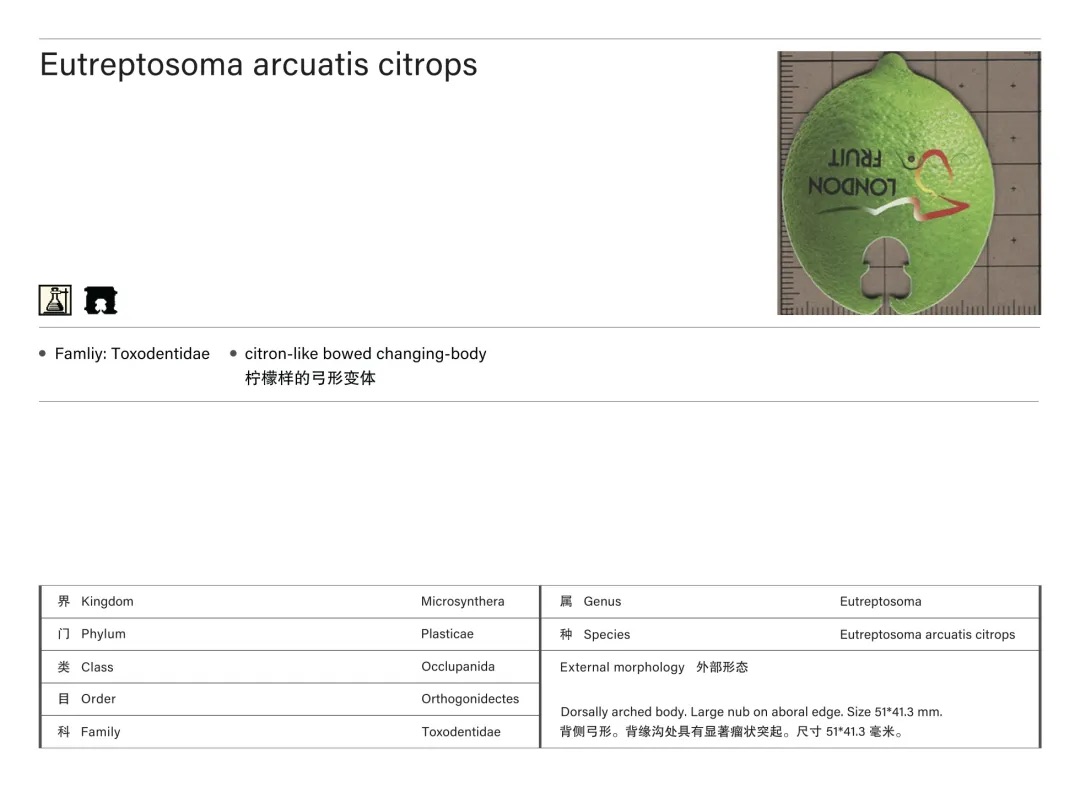
A rarely encountered subspecies of the extremely mutable Eutroptosoma arcuatis. This specimen was acquired in a laboratory setting, but reports in the field have been confirmed.
极易变异的Eutroptosoma arcuatis中的一个很少见的亚种。该标本是在实验室环境中获得的,但野外报告已得到证实。
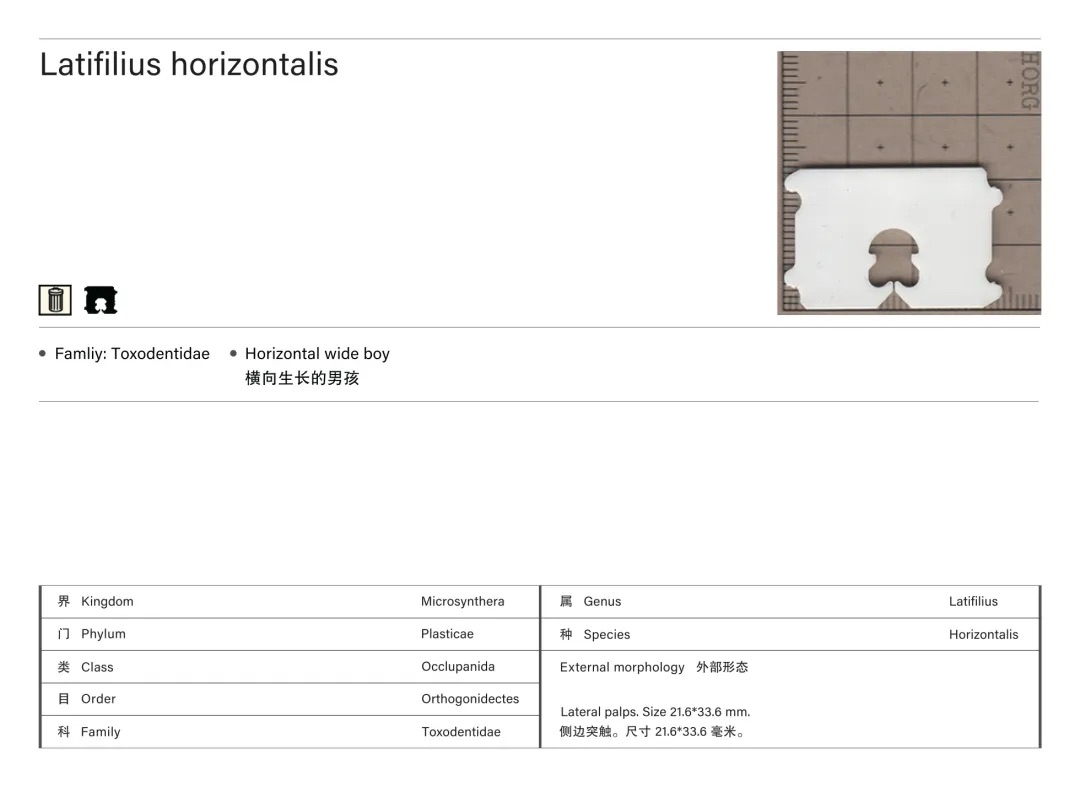
A hoax? A mutation? A mistaken image aspect ratio? When reports of this bizarre Toxodentid surfaced, members of HORG were skeptical. Discovered in a surplus box at a recycling facility, It quickly became something of a legend, captivating the imagination of many occlupanologists who dubbed it the “Widest Boi”. Its stalwart discoverer L. Helm (FORC) persevered and sent in their specimen for taxonomic review. Forced to confront the physical undeniability and distorted morphology of Latifilius horizontalis, even the most jaded abiotic systematist could not help but stare at it in slack-mandibled wonder. Nothing is known about its host, but the presence of glue and paper on its obverse side indicates the presence of an equally extra-wide amiculum. To date only a single specimen is known to exist.
是骗局?是突变?还是图像比例失调的误导?当这一怪异的Toxodentid的报告首次出现时,HORG成员起初都持怀疑态度。该标本发现于某回收站的闲置物品箱中,随后迅速成为传奇般的存在,被众多Occlupanid研究员戏称为”最宽的男孩(Widest Boi)"。其忠实的发现者L. Helm(FORC)坚持将标本提交分类学审核。面对Latifilius horizontalis无可辩驳的实体标本及其扭曲的形态特征,即便最资深的非生物系统学家也情不自禁地张嘴结舌,目不转睛地凝视着它,满眼不可置信的惊奇。虽宿主信息未知,但其正面残留的胶质与纸屑表明它曾附着在一个同样超常规格的物品上。迄今仅发现单一标本存世。
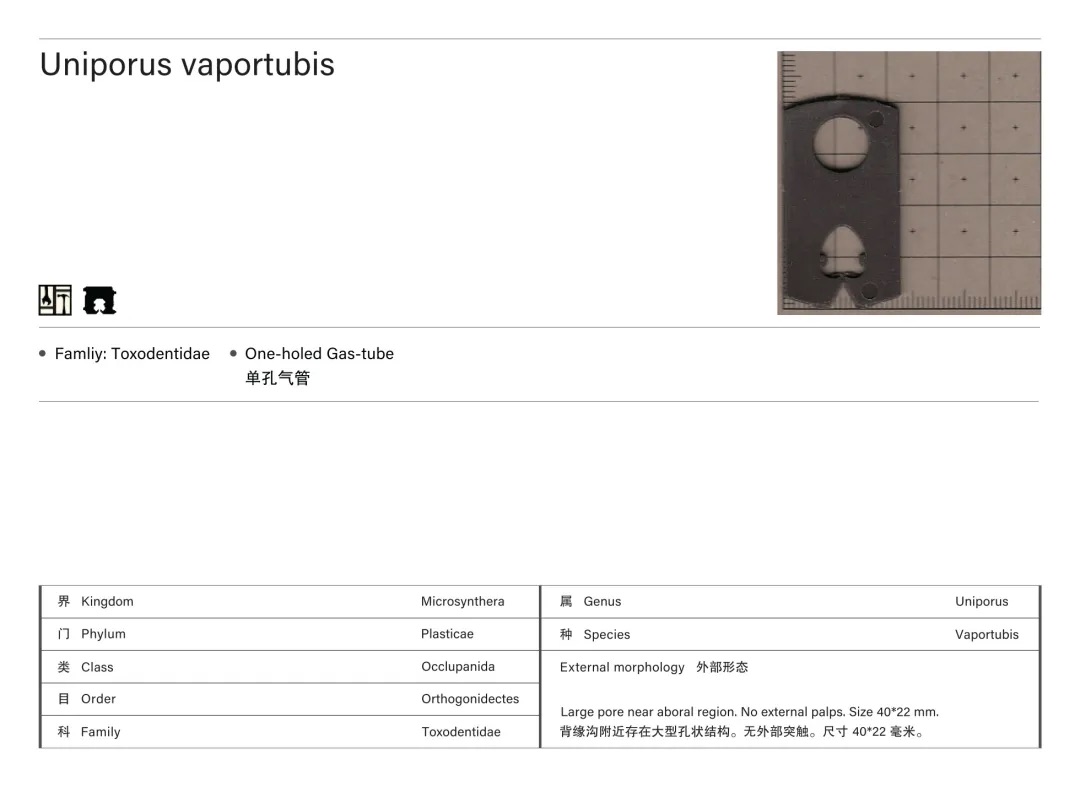
U. vaportubis is a species that is only found in hardware stores, clutched on bags of dryer vent tubes. It is this species that led to the discovery that occlupanids do not take organic nourshment from the contents of the plastic bag, but from the bags themselves. The circular hole’s function is unknown. The dark brown integument is noticably thicker than most occlupanids. Shares a similar niche to Deuterofenestrum trexlerii.
U. vaportubis是一种目前仅在五金店中被观察到的Occlupanid,常紧紧附着在烘干机通风管的包装袋上。正是由于这一物种的研究,才首次揭示出一个关键事实:Occlupanid并非依赖包装袋内的内容物获取营养,而是以塑料袋本身为“宿主”。其体表的圆孔功能尚未明确,但可观察到其深褐色表皮结构明显厚于多数Occlupanid 。该物种与Deuterofenestrum trexlerii 具有相似的生态位。
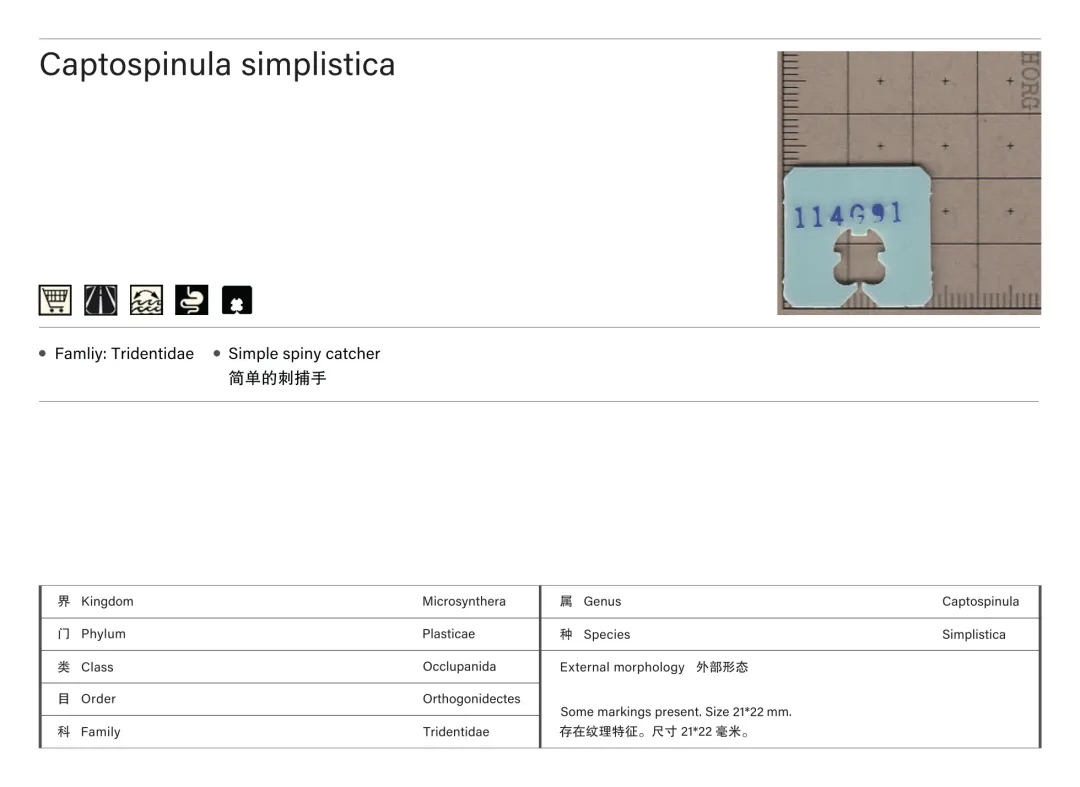
Considered to be the most basal of family Tridentidae. Common in grocery stores and other environs. The genus Captospinula has recently caused some controversy when the Board of Synthetic Taxonomy changed several species from their former genus name, Appatens. Though many alterations to scientific names are made because of new data or discovery of error, this decision was made because not a single researcher at HORG could remember what “appatens” actually meant. The change has caused many of the general public to be outraged by this capricious shift in appelation, with small public demonstrations for the old name held in grocery stores, and the sale of ironic t-shirts with “I Remember Appatens” printed on them.
作为Tridentidae科中最基础的种,该物种常见于杂货店及其他环境中。Captospinula属近期引发了命名争议——合成分类学委员会(Board of Synthetic Taxonomy)将数个物种从原属名Appatens中划出更名归入该属。虽然许多科学名称的修改都是基于新数据或发现错误而进行的,但这次改名的原因却是因为HORG研究所没有一位研究员能记得“Appatens”究竟是什么意思。这一决定引发了公众的强烈不满,导致在杂货店等地爆发了小规模的旧名支持示威,还有一些带有“I Remember Appatens”(我记得Appatens)的讽刺性T恤衫开始销售。
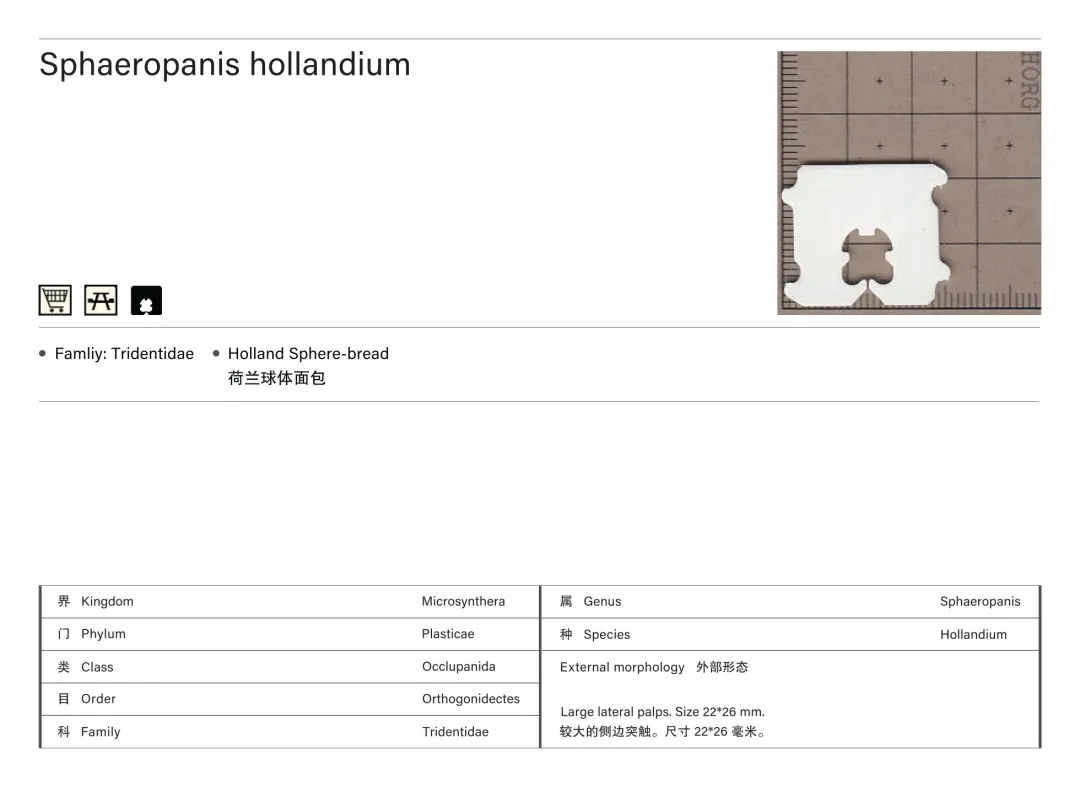
A truly international occlupanid. Occlupanids from Europe are rare, due to the prevalence of easily-obtainable fresh bread. However, several Tridentids new to science were discovered by amateur occlupanologists W. Mense and A. Baban in South Holland. Three specimens of Sphaeropanis were captured where they were found attached to bags of ball-shaped Dutch pastries known as bolletjes. They were then sent directly to the HORG offices, where their description was corroborated.
Half a world away, another pair of researchers made a similar discovery. Occlupanologists P. Steinmetz and J. Krauss noticed Sphaeropanis hollandium clutched to a bag of biscuits in Upington, South Africa, and collected yet another from a park in Botswana! That specimen is also part of the HORG international collection, and demonstrates how human cuisine and cultural ties can affect the spread of these magnificent microsyntherans. Additionally in 2018 a specimens of S. hollandium was found in Melbourne, Australia by L. de Gaillande, and in Canada by M. Quinn and L. Wallace.
这是一种真正国际化的Occlupanid。由于欧洲盛行新鲜面包,易得且无需包装,Occlupanid在当地较为罕见。然而,业余Occlupanid研究员W. Mense和A. Baban在南荷兰省发现了多个科学界未知的Tridentids科物种。在那里,他们在一种名为Bolletjes的球形荷兰甜点包装袋上采集到三枚Sphaeropanis标本,并直接寄送至HORG机构完成鉴定认证。
与此同时,在地球的另一端,另一组研究者也有类似发现——Occlupanid学家P. Steinmetz和J. Krauss在南非阿平顿观察到Sphaeropanis hollandium附着于一袋饼干包装上,之后又在博茨瓦纳的一座公园中采集到另一枚标本。这些标本均纳入HORG国际馆藏,生动展示了人类饮食习惯和文化联系如何影响这些神奇的Microsyntherans的传播。此外在2018年,L. de Gaillande在澳大利亚墨尔本,M. Quinn和L. Wallace在加拿大也分别发现了S. hollandium标本。
*There are many different Occlupanids waiting to be seen and discovered.
*现场还有许许多多不同的Occlupanids等待大家去观察和发现。
*现场还有许许多多不同的Occlupanids等待大家去观察和发现。

Since 1994 HORG has been receiving letters from people all over the world about their Occlupanid collection and observations. A selection of these letters is shown in the exhibition.
从94年开始HORG陆续收到世界各地人们寄来的不同的关于他们对于Occlupanid收集和观察的来信。展览选取小部分信件展出。

Letters_Bambi
HORG,
Enclosed are some samples I’ve collected, as well as a sketch depicting my theories. I surely am not the first to imagine these little guys as some sort of arthropods. Regardless, I hope my findings aid your research further. Best of luck.
Bambi
HORG(Occlupanid研究小组)您好:
随信附上我收集的一些样本,还有一幅描绘我理论的素描。我肯定不是第一个把这些小家伙想象成某种节肢动物的人。不过,无论如何,我希望我的发现能对你们的研究有所帮助。
Bambi

Letters_Bee
To whom it may interest
These were found in the wild of Tecumseh, Saline, Ypsilanti, & Dexter, MI, respectfully.The lighter green one put up a fight, ripping the clothes of the rescue agent tasked with subduing & rescuing it. It is quite a feisty one!
Warm regards,
Bee Wilson
可能对此感兴趣的人:
这些(面包夹)是在密歇根州的特库姆塞、萨林、伊普西兰蒂和德克斯特的野外被发现的。
浅绿色的那个反抗得很激烈,甚至撕破了负责制服和营救它的救援人员的衣服。它确实是个火爆的小家伙!
Bee Wilson
2022年1月22日

Letters_Marty
Hello!
I found this little guy in Morton Grove, IL at Aldi on some Maple French Toast Bagels. I’ve never seen a cardboard one before, so I figured I’d send it in.
Thanks for the work you do!
Warm regards,
Marty
你好!
我是在伊利诺伊州莫顿格罗夫的Aldi超市,在一袋枫糖法式吐司味贝果上发现了这个小家伙。我以前从没见过纸板材质的,所以就想着寄给你们。
感谢你们所做的工作!

Letters_Elena
Dear HORG,
With this letter I’m sending you two specimens of S. hallandium, purchased with (grape?) fruit raisin buns in late June 2020 in Kiel, northern Germany.
The marking “M.H.D.” above the date (dd.mm.yy) means “Mindestens haltbarkeitsdatum” as explained in the accompanying e-mail. The alpha-numeric code on the side is constant, even with a newer sample, so it can’t be the charge number—it might be an ID of some sort still, maybe for the factory? Must be some constant factor that is associated with it anyway. On the package there is no information about the origin of the buns.
To my knowledge, there is no German word for occlupanids in common use. Ironically, they might be referred to as a “clip” or something, just borrowing yet another English word.
I will keep my eyes open for any further new discoveries of occlupanids of this type.
Sincerely,
Elena Diehl
(bottom: two attached occlupanid specimens marked 29.06.20 and 07.07.20)
亲爱的HORG,
随信附上两枚S. hallandium的标本,是我在2020年6月底于德国北部城市基尔(Kiel)购买葡萄干面包(raisin buns)时发现的。
标注“M.H.D.”(在日期前,如dd.mm.yy格式)意为“Mindestens haltbar bis datum”(即“保质期至”,详见随附邮件说明)。夹子的字母数字编码即使在更新的样本中也保持一致,因此不太可能是批号;它可能是某种ID号,或是工厂用来识别某类产品的代码?无论如何,它似乎是与某个恒定因素相关的编号。在包装上没有关于面包来源的其他信息。
据我所知,德语中并没有对这类Occlupanid专用的常用词汇。有趣的是,他们可能会借用“clip”或类似的英语词汇来称呼它。我会继续留意是否还有这类Occlupanid的新发现。
Elena Diehl
(下方贴有两个样本,2020年6月29日和2020年7月7日)

Letters_Unknow
Dear HORG, and the Sirs or Madams within:
Enclosed are 3 samples; one white, one green, one yellow.
Discovered on bagel bags in northern California, they are notable for their markings. I believe they are all of family Toxodentidae.
White sample has markings in an odd font.White also has inverted palps (the other two are enclosed mostly as reference).Yellow and green have text "archway" patterns I have yet to see in their own classification.Thank you for your time.
亲爱的 HORG 以及在内的先生/女士们:
随信附上三枚样本:一枚白色、一枚绿色、一枚黄色。它们是在美国加州北部的贝果包装袋上发现的,因其特殊的标记而引人注意。我认为它们都属于 Toxodentidae。白色样本使用了奇特的字体进行标记。白色样本也具有反向触角(另外两枚主要作为参考附上)。黄色和绿色样本上有“archway”式图案文字,目前尚未在已知分类中见到。感谢您抽出时间阅读。

Letters_Lenin Quirez
Lenin Quiroz
27 July 2020
Dear Holotypic Occlupanid Research Group, Enclosed are a few occlupanid samples for the team. I believe they might be from the stockpile, having found nothing incredibly special. However, I hear about the wonderful things you do with these small components! So even if these aren’t exactly special, I still get the opportunity to share what I find.
The work that you do is incredibly important and inspiring to hear. I just recently found out about the HORG through a late night drift on the internet. While I don’t have a collection or am a particularly trained scientist, I love to see what others have done in this area. Although I hope these help in some way, as someone with a deep appreciation to the medical field, I really do appreciate the value of your research. Thank you for your wonderful dedication to science and for your service. I wish you all the best! Stay safe!
日期:2020年7月27日
亲爱的 Holotypic Occlupanid Research Group(HORG):
随信附上几种“咬合样本”。我认为它们可能来自市售的面包袋,没有什么特别之处。不过,我听说你们收集各种各样的这些夹子(无论多么普通)!因此,即使这些不太特别,我还是想趁这个机会寄给你们看看。
你们所做的工作非常重要而迷人!我最近才发现 HOLRG,并为你们的研究感到惊讶。我本身并不是一个科学家,也没有很大的收藏。但我确实喜欢各种各样的收藏品。虽然我希望能提供更珍稀的样本,但我依然衷心希望这些能对你们有帮助。作为一个非常欣赏研究工作价值的人,我衷心感谢你们对科学的奉献。祝你们一切顺利!注意安全!

Envelopes


The graphic design of this exhibition is based on the visual language of Occlupanid, transforming its morphological features into a new writing system. The design of the exhibition typeface is derived from Occlupanid's structural analysis: oral groove, palps, and fenestra have been distilled into geometrically constructed elements, forming a typeface that is 'non-life and non-material' . Through this systematic translation, we intend to give the graphic language a pseudo-scientific sense of order: calm and restrained, but also implying the impulse of interpretation and naming. The visual system mimics the logic of numbering and the tone of classification in an archive, referencing the layout of museum classification cards and technical manuals, and establishing a quasi-scientific narrative tone in the relationship between typeface, white space, and labelling. Occlupanid is no longer an ignored and discarded component, but rather an iconographic basis for organising information and generating order - as if it were some kind of microcosmic civilisation. Occlupanid is no longer a discarded component, but a graphic basis for organising information and generating order - as if it were some kind of microcosmic civilisation that is gradually taking shape through the language of the plane. The foldout design of the exhibition is also in the style of a scientific archive, where you can collect and record your observations of the Occlupanid on the foldout archive.
本次展览的平面设计以Occlupanid的视觉语言为基础,将其形态特征转化为一种新的文字系统。展览字体的设计源于自Occlupanid的结构分析:口腔沟、突触、窗孔结构等被提炼为几何化的构形元素,形成一种“非生非物”的字体形象。我们意图借由这一系统性的转译,赋予平面语言以伪科学的秩序感:既冷静、克制,又暗含演绎与命名的冲动。整个视觉系统模拟了档案馆的编号逻辑与分类语调,参考博物分类卡片与技术手册的布局,在字体、留白与标注关系中建立一种准科学的叙事基调。Occlupanid不再是被忽略的废弃构件,而成为组织信息、生成秩序的图像学基础——仿佛某种微缩文明,借助平面语言,逐渐显形。展览的折页设计也以科学档案的设计风格存在,你可以在折页的档案上收集和记录观察到的Occlupanid们。



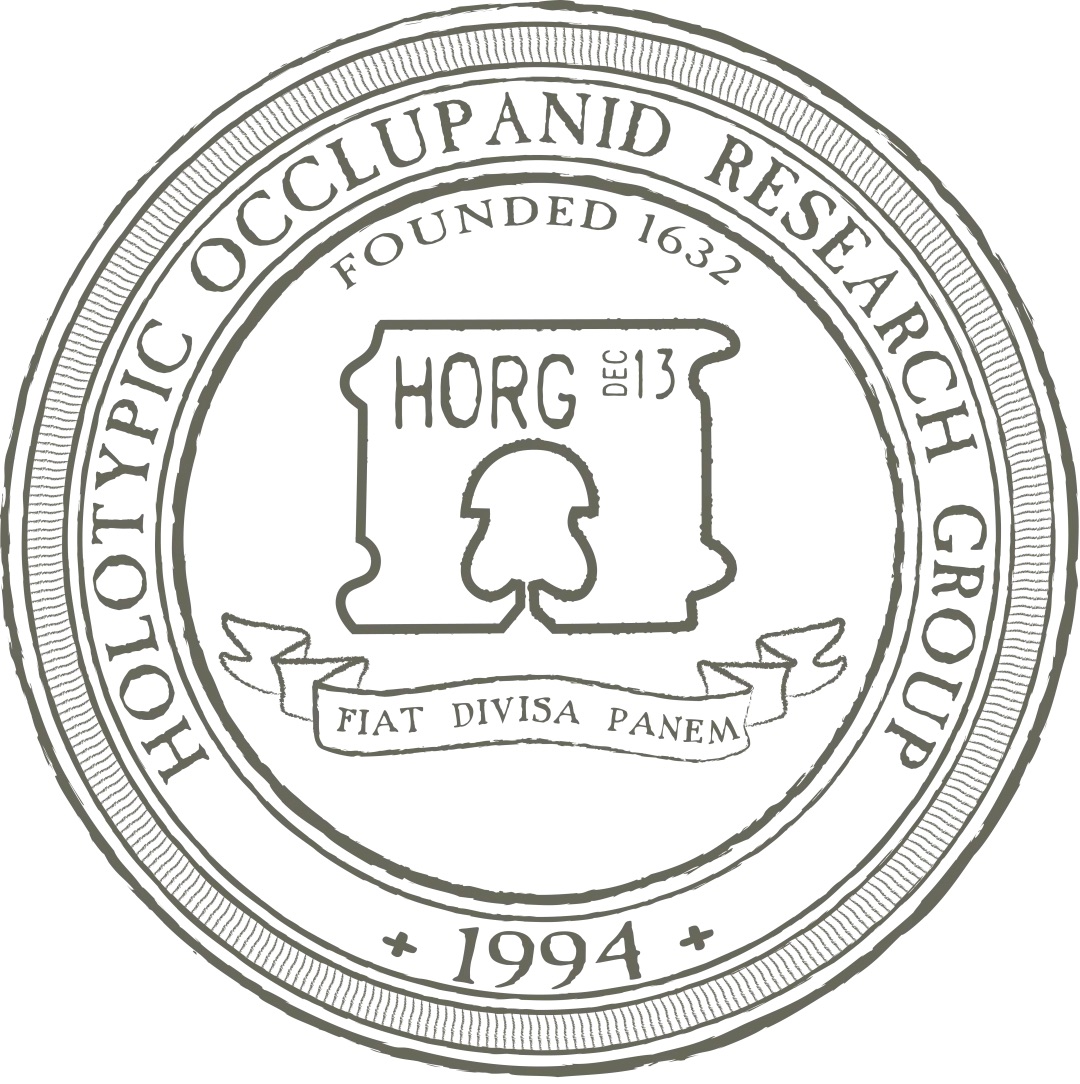
The Holotypic Occlupanid Research Group is a nonprofit organization dedicated to the study, education, and preservation of a group of inanimate objects that garners little attention in our modern world. Its use in our society is ignored, and its fascinating forms and colors are underappreciated. In order to promote greater Occlupanid awareness, and to introduce a comprehensive taxonomy to the scientific community, HORG was founded.
The Holotypic Occlupanid Research Group(HORG) https://www.horg.com
Holotypic Occlupanid Research Group, 简称HORG,是一个非营利组织,致力于研究、教育与保护这样一类在当代世界中鲜少受到关注的无生命物体。它们在社会中的用途常被忽视,其迷人的形态与色彩也未曾得到应有的欣赏。为提升大众对Occlupanid的认知,并向科学界引入一套全面的分类体系,HORG因此应运而生。

爱心面包夹T恤
Love-Heart Occlupanid T-Shirt


合作组织 Cooperative organisation:
Holotypic Occlupanid Research Group(HORG)
码数:均码
胸围 Chest:110cm 肩宽 Shoulder:51cm 衣长 Length:73cm
材质Material:纯棉 Cotton
工艺 Process:数码直喷
以一个心形的面包夹(Occlupanid)为T恤的符号,采用柔软透气的纯棉材质,适合日常穿着。
Featuring a heart-shaped breadclip (Occlupanid) as the T-shirt's symbol, it's made from soft, breathable cotton for everyday wear.
面包夹Family 异形贴纸
Occlupanid Family Stickers


合作组织 Cooperative organisation:
Holotypic Occlupanid Research Group(HORG)
尺寸 Size:16*8cm(35个图案)
材质 Material:透明PVC不干胶亮膜
工艺 Process:彩印、亮膜 Color printing with glossy finish
汇集了多样的面包夹们,到处贴贴和发现可爱的面包夹们!
All kinds of occlupanids, all in one place!Stick them here, stick them there — and enjoy finding these little cuties wherever you go.
面包夹清洁木浆绵Holotypic Occlupanid Research Group(HORG)
尺寸 Size:16*8cm(35个图案)
材质 Material:透明PVC不干胶亮膜
工艺 Process:彩印、亮膜 Color printing with glossy finish
汇集了多样的面包夹们,到处贴贴和发现可爱的面包夹们!
All kinds of occlupanids, all in one place!Stick them here, stick them there — and enjoy finding these little cuties wherever you go.
Occlupanid cellulose sponge



合作组织 Cooperative organisation:
Holotypic Occlupanid Research Group(HORG)
尺寸 Size:100*123mm
材质 Material:天然木浆棉 Natural cellulose sponge
(30%棉花 Cotton 70%木浆纤维 Wood pulp fibe)
工艺 Process:异形切割 Die-cut shape
两款面包夹图案制作的清洁木浆棉,彩色异形,可以用来洗手,洗碗和清洁桌面,面包夹的开口帮助你挂在金属架周围方便使用。
Two cleaning sponges made in the shape of bread clips, with colorful irregular forms. They can be used for washing hands, doing dishes, and cleaning tabletops. The bread clip opening allows you to hang them on metal racks for convenient use.
面包夹Fmaily 和纸胶带
Occlupanid Family japanese paper tape


合作组织 Cooperative organisation:
Holotypic Occlupanid Research Group(HORG)
尺寸 Size:20mm*5m
循环长度 Loop length:40cm
材质 Material:和纸胶带(无离合纸 Liner-free)
工艺 Process:彩印 Color printing
和纸胶带呈现了多个不同的面包夹的图案,随意选取和使用。
Featuring a variety of unique occlupanid illustrations, this washi tape is perfect for cutting, sticking, and playing.
Love-Heart Occlupanid Tote Bag


合作组织 Cooperative organisation:
Holotypic Occlupanid Research Group(HORG)
尺寸 Size :38*42cm(袋身) 2.5*75cm(肩带)
材质 Material:精梳斜纹棉布 Combed twill cotton
工艺 Process:双面数码直喷 Double-sided digital printing
绿色带来夏天的好心情,选用了薄的彩色棉布搭配面包夹图案,可爱百搭^_^
A cheerful splash of green brings the joy of summer!This lightweight, colorful cotton bag is paired with adorable occlupanid (bread clip) patterns—cute, versatile, and ready to match any outfit. ^_^
Holotypic Occlupanid Research Group(HORG)
尺寸 Size :38*42cm(袋身) 2.5*75cm(肩带)
材质 Material:精梳斜纹棉布 Combed twill cotton
工艺 Process:双面数码直喷 Double-sided digital printing
绿色带来夏天的好心情,选用了薄的彩色棉布搭配面包夹图案,可爱百搭^_^
A cheerful splash of green brings the joy of summer!This lightweight, colorful cotton bag is paired with adorable occlupanid (bread clip) patterns—cute, versatile, and ready to match any outfit. ^_^













































Occlupanid:面包夹作为一种生物
Occlupanid: Plastic bread tag as an organism
卡斯普多特 cuspdot
杭州市上城区凤山路79号商业储运有限公司3仓3楼303
2025.7.5 - 2025.8.31 6/7
策划:葛睿璟,黄懋冰,任雨薇,HORG
视觉设计:Nlieechi (Li Chengjie)
致谢:家心,kiwi, 徐楠,Huhu,Yuwan,Ruotong,蔺彤,maomao,一文,gt, 小小,Herbr
Curated by Ruijing Ge, Huang Maobing , Ren Yuwei, HORG
Visual Design by Nlieechi (Li Chengjie)
Special thanks to Jiaxin, Kiwi, Xu Nan, Huhu, Yuwan, Rutong, Lintong, maomao, yiwen, gt, xiaoxiao, Herbr